Finally! It's done!
This review kicked my butt. Obtaining accurate, anechoic data from 20Hz to 20kHz with resolution down to 20Hz intervals without an NFS or anechoic chamber is a daunting task. I spent multiple days measuring, analyzing and re-measuring the speakers. Hoisting this large speaker on to a 6 foot platform for 4-pi measurements and spending a lot of time getting groundplane spin data. This results in response data not provided by any other outlet both in vertical and horizontal planes, short of Amir's NFS and manufacturer's anechoic data. I would estimate I have 30+ hours in this the data and analysis of this review alone. Sure, I'm patting myself on the back but I can absolutely guarantee no one else has gone through the efforts I have for this review. So, yea, I am puffing my chest. It's not my nature but I worked hard on this review and the efforts paid off. My results are within 1dB of HARMAN's own spinorama data and I have been given the thumbs up by their engineering team.
As always, the below review is literally copy/pasted from my website. Therefore, some tables may not translate as well to the forum format. So, if you want to read the review in the intended format simply go to the link below:
https://www.erinsaudiocorner.com/loudspeakers/revel_f226be/
Let's get to it...
Revel PerformaBe F226Be Floorstanding Speaker Review
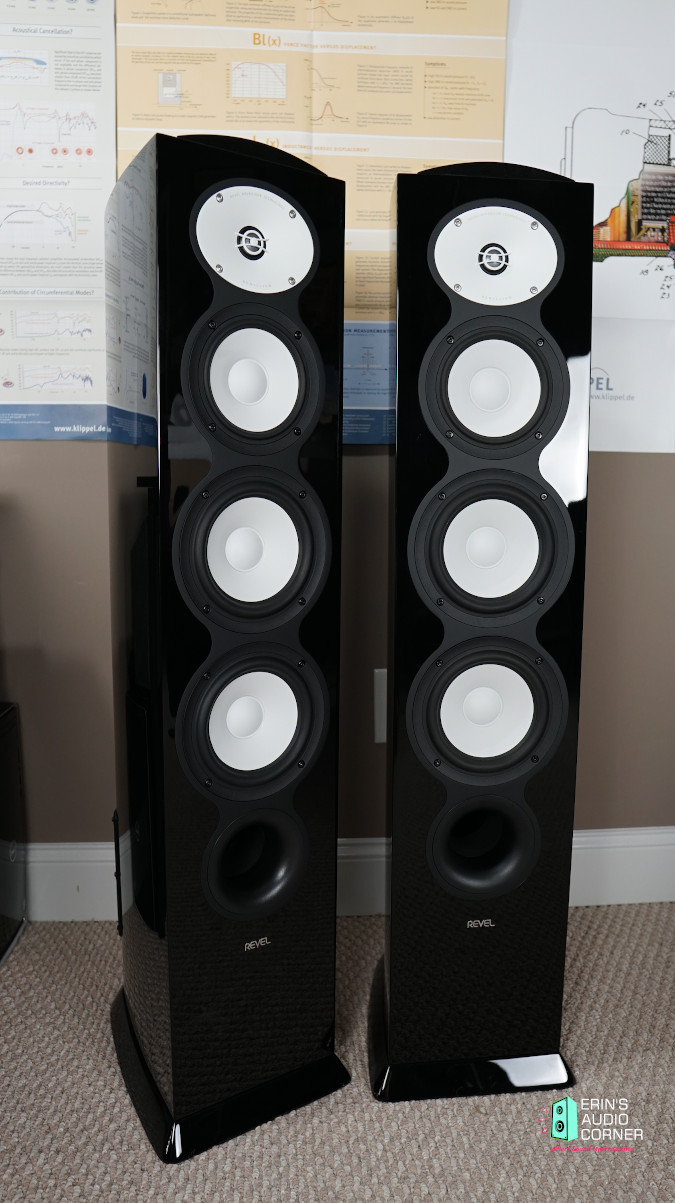
Intro
The Revel Performa F226Be is a “compact” floorstanding 3-way loudspeaker from Revel’s PerformaBe lineup featuring (2) 6.5-inch midwoofers, a single 5.25-inch midrange and a 1-inch Beryllium dome tweeter on a waveguide. This speaker retails for $3500 USD/each ($7k USD/pair).
I have taken the liberty of copy/pasting specifications directly from Revel’s website below:

The 1-inch Beryllium dome tweeter features an acoustic lens to help control dispersion while also serving to protect the tweeter from damage (this tweeter being made of Beryllium, a needed feature). The relatively shallow waveguide provides directivity control designed to match the response of the midrange at the crossover to create a smooth “hand off” between drivers both horizontally and vertically.
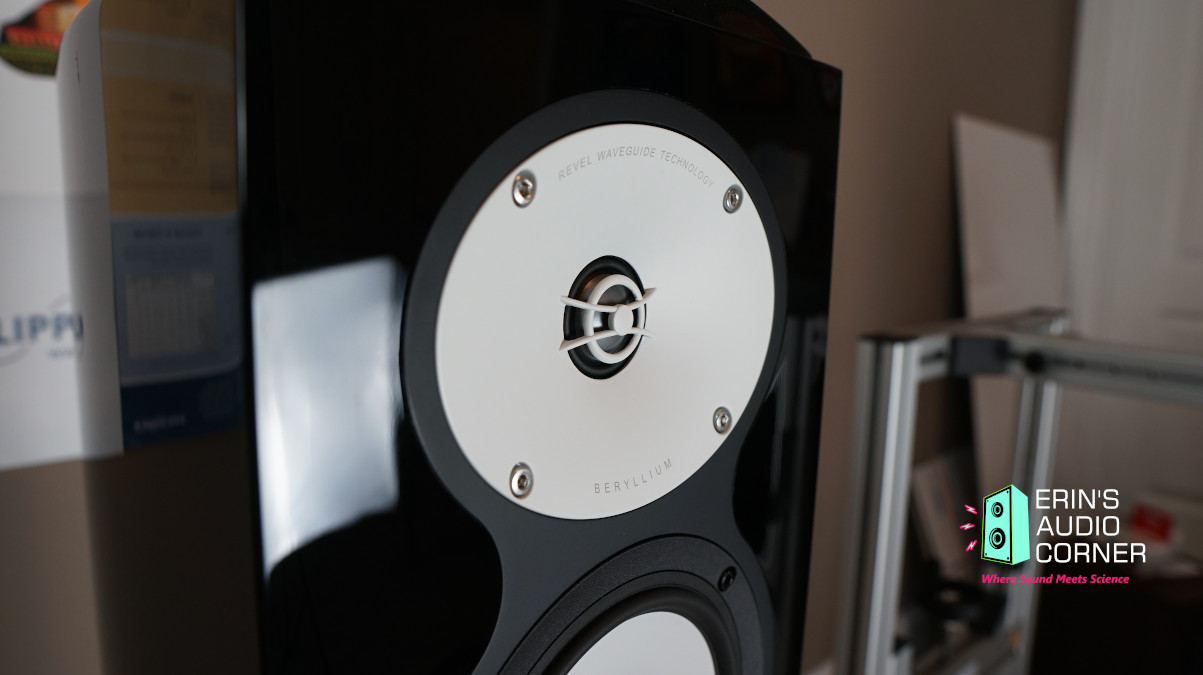
The 5.25-inch midrange features a different surround than that of the midwoofers. I find this interesting because many manufacturers make essentially the same drive units in various sizes for different implementations. While the T/S specs often reflect the intended use (such as a higher or lower Fs), the look of the drive units is often identical; just scaled in size. This midrange drive unit, however, features a distinctly different surround than that of the midwoofers. While I thought this was to reduce diffraction I hadn’t considered the obvious reason which HARMAN told me was the basis: The reason is not for directivity or diffraction. Rather, a smaller surround radius with a correspondingly larger diameter diaphragm reduces moving mass, plus larger cone area equals higher efficiency, which reduces compression. So, senstivity. Makes sense.
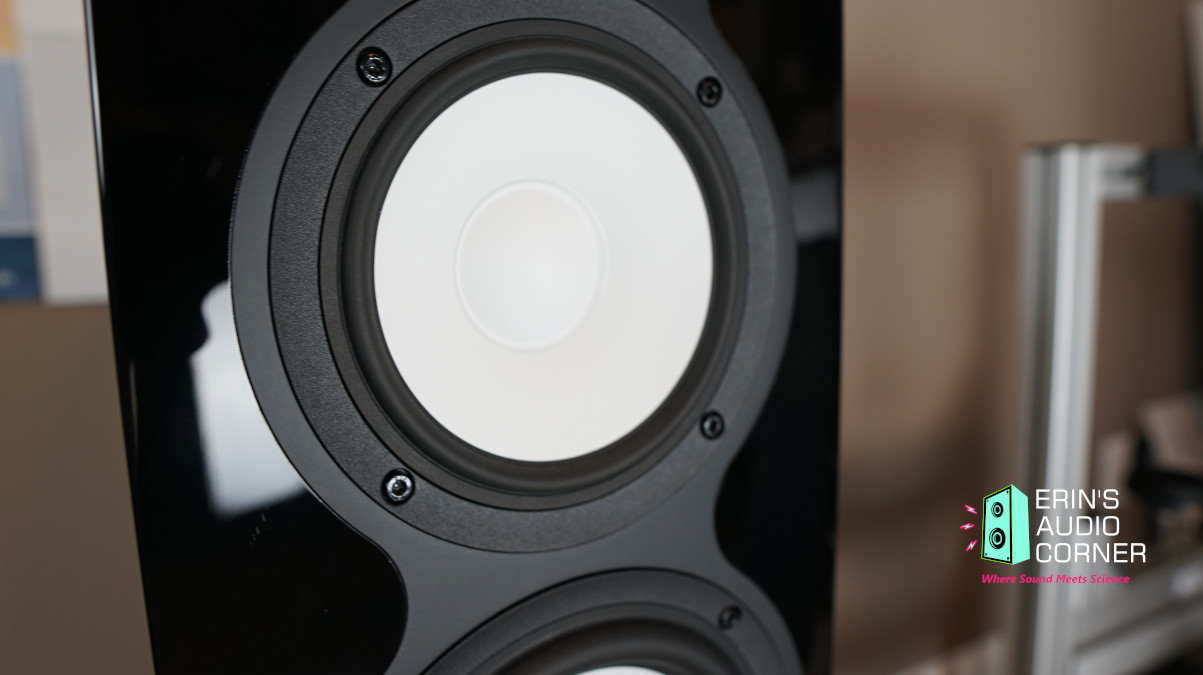
5.25-inch midrange on top. 6.5-inch midwoofer on bottom. Again, notice the different surrounds.
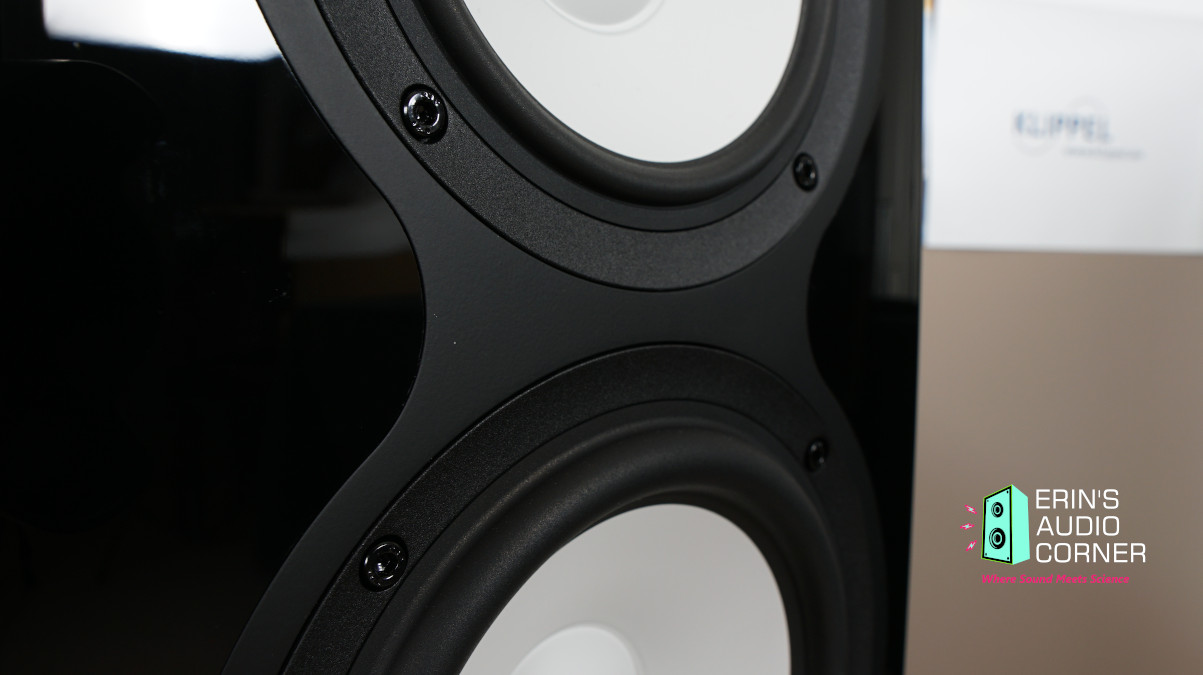
Dual 6.5-inch midwoofers and front-mounted port.
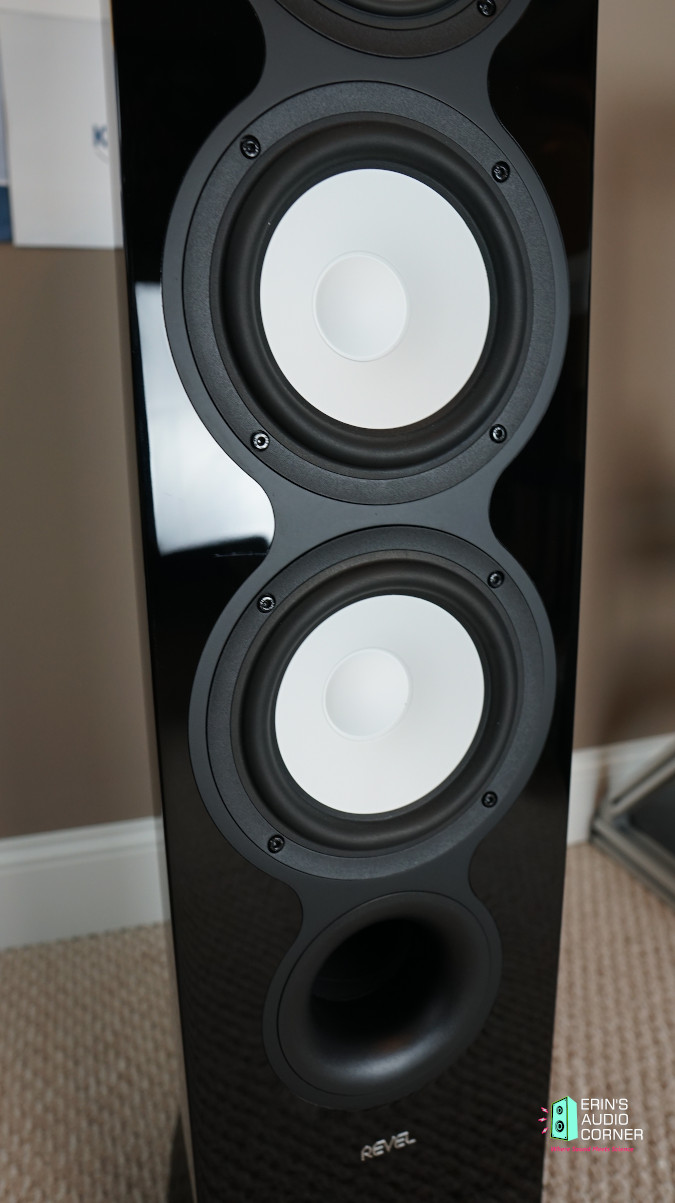
Rear speaker connections, implementing 5-way binding posts with the option to bi-amp or bi-wire the speakers if so desired.
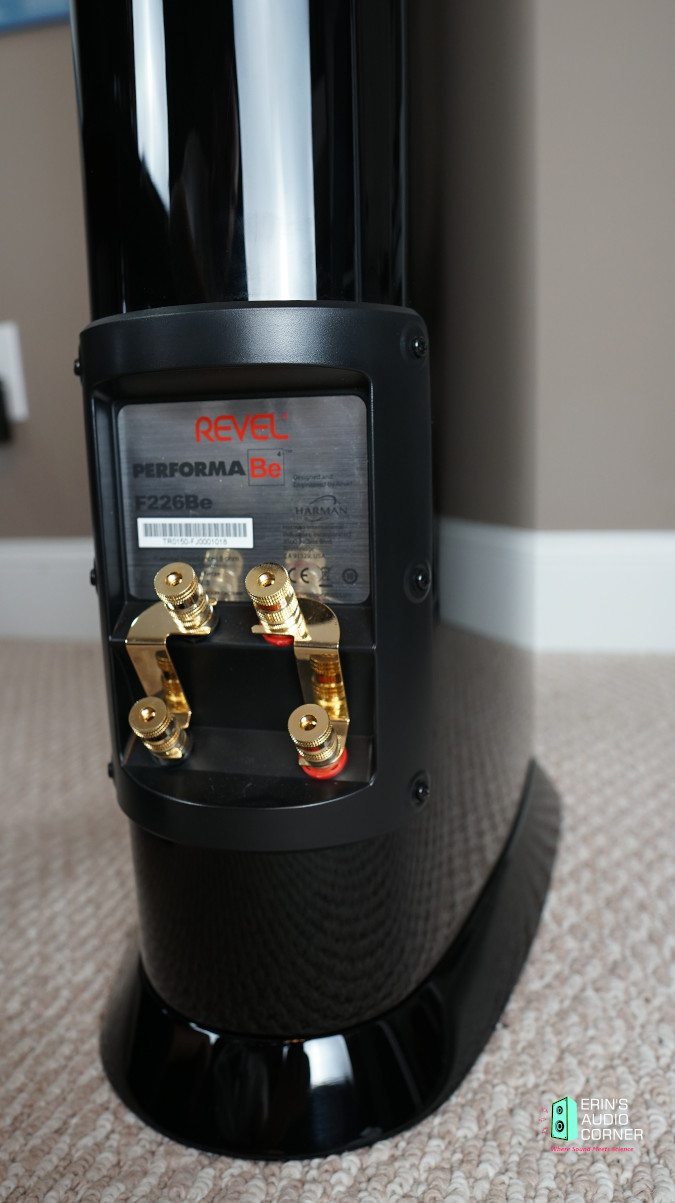
Objective Data
Unless otherwise noted, all the data below was captured using Klippel Distortion Analyzer 2 and Klippel modules (TRF, DIS, LPM, ISC to name a few). Most of the data was exported to a text file and then graphed using my own MATLAB scripts in order to present the data in a specific way I prefer. However, some is given using Klippel’s graphing.
Foreword: Subjective Analysis vs Objective Data (click for more)
Impedance Phase and Magnitude:
Impedance measurements are provided both at 0.10 volts RMS and 2.83 volts RMS. The low-level voltage version is standard because it ensures the speaker/driver is in linear operating range. The higher voltage is to see what happens when the output voltage is increased to the 2.83vRMS speaker sensitivity test.
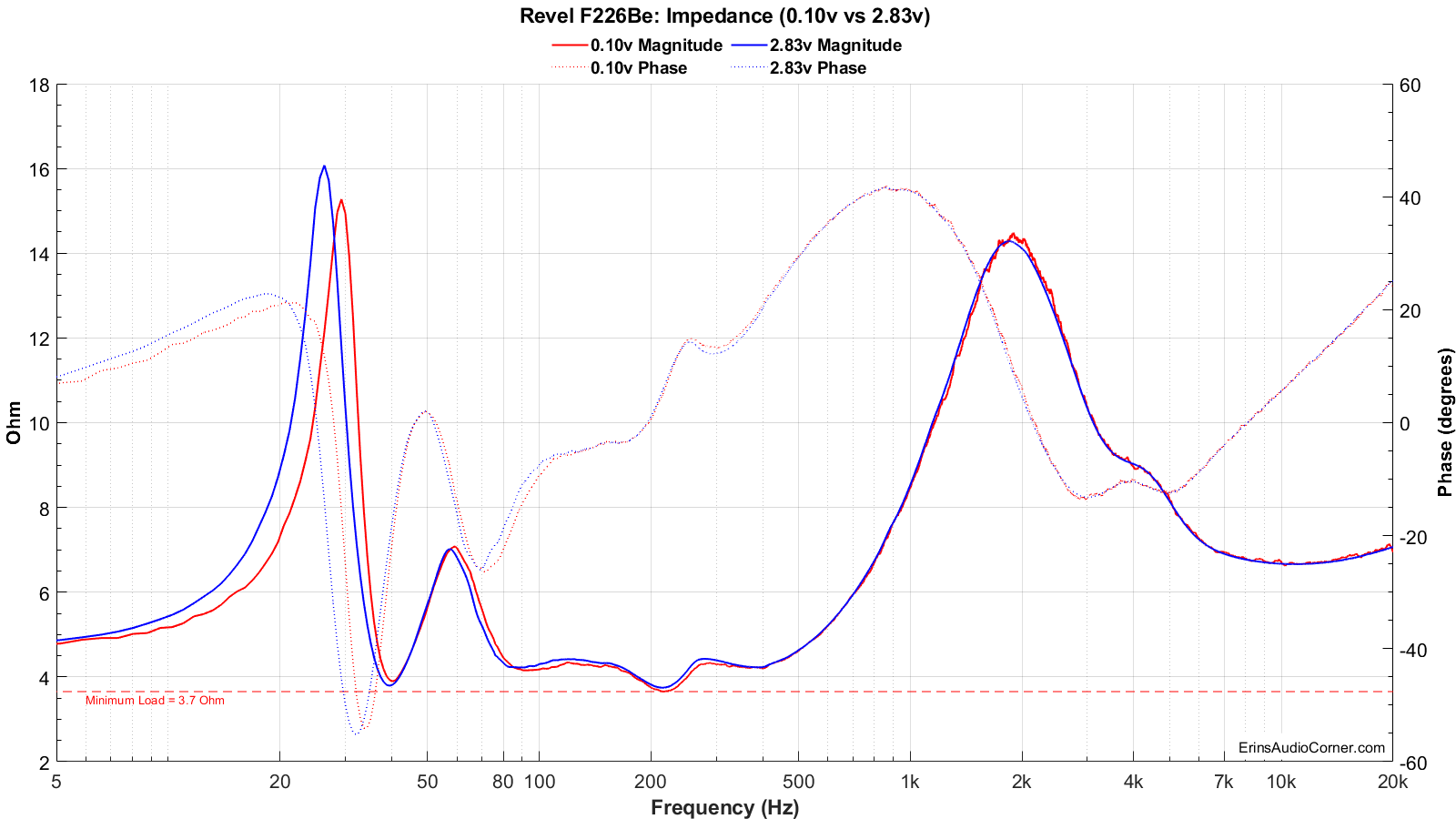
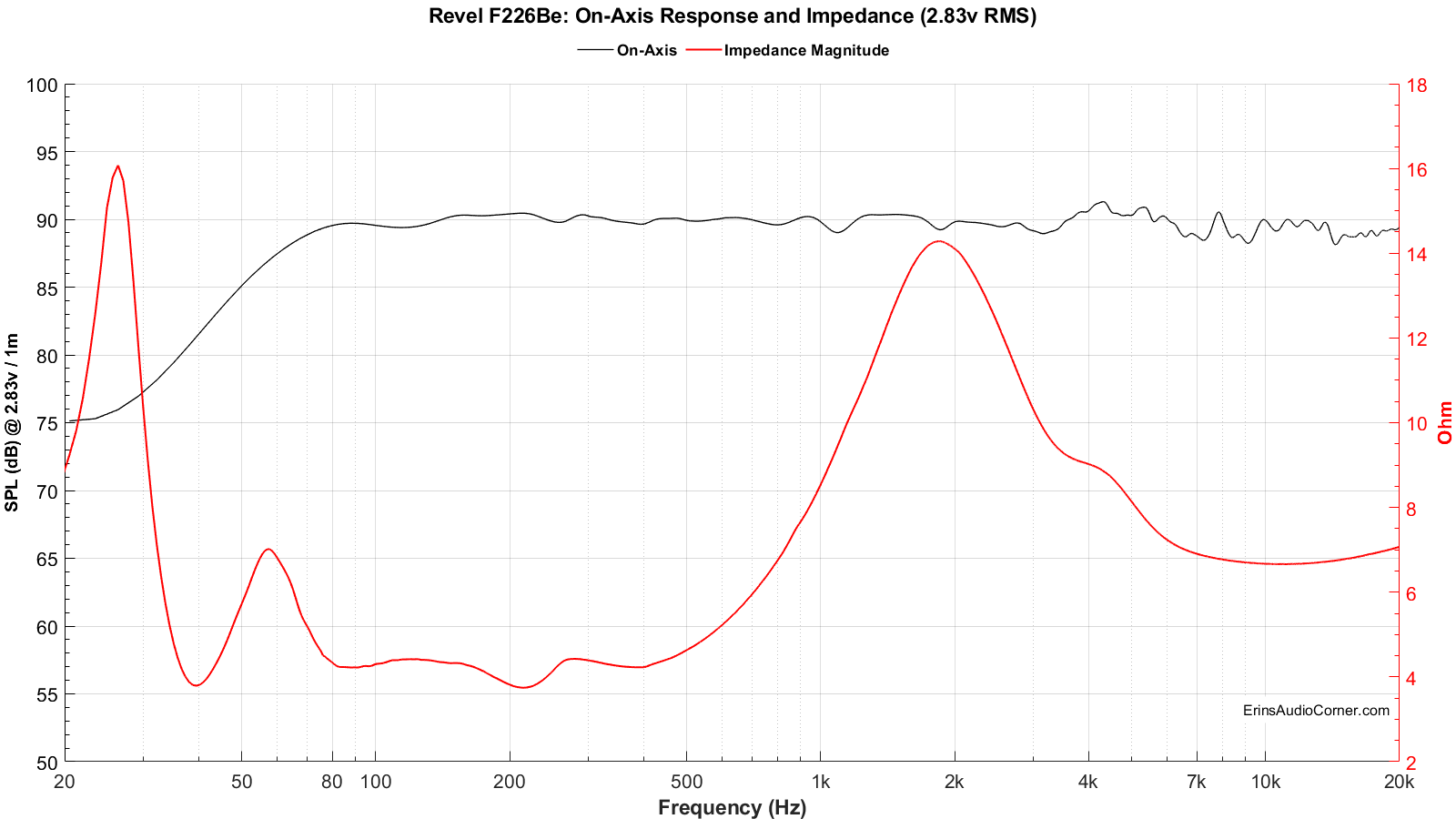
Frequency Response:
Notes about measurements (click for info)
The measurement below provides the frequency response at the reference measurement axis - also known as the 0-degree axis or “on axis” plane - in this measurement condition was situated at the tweeter.
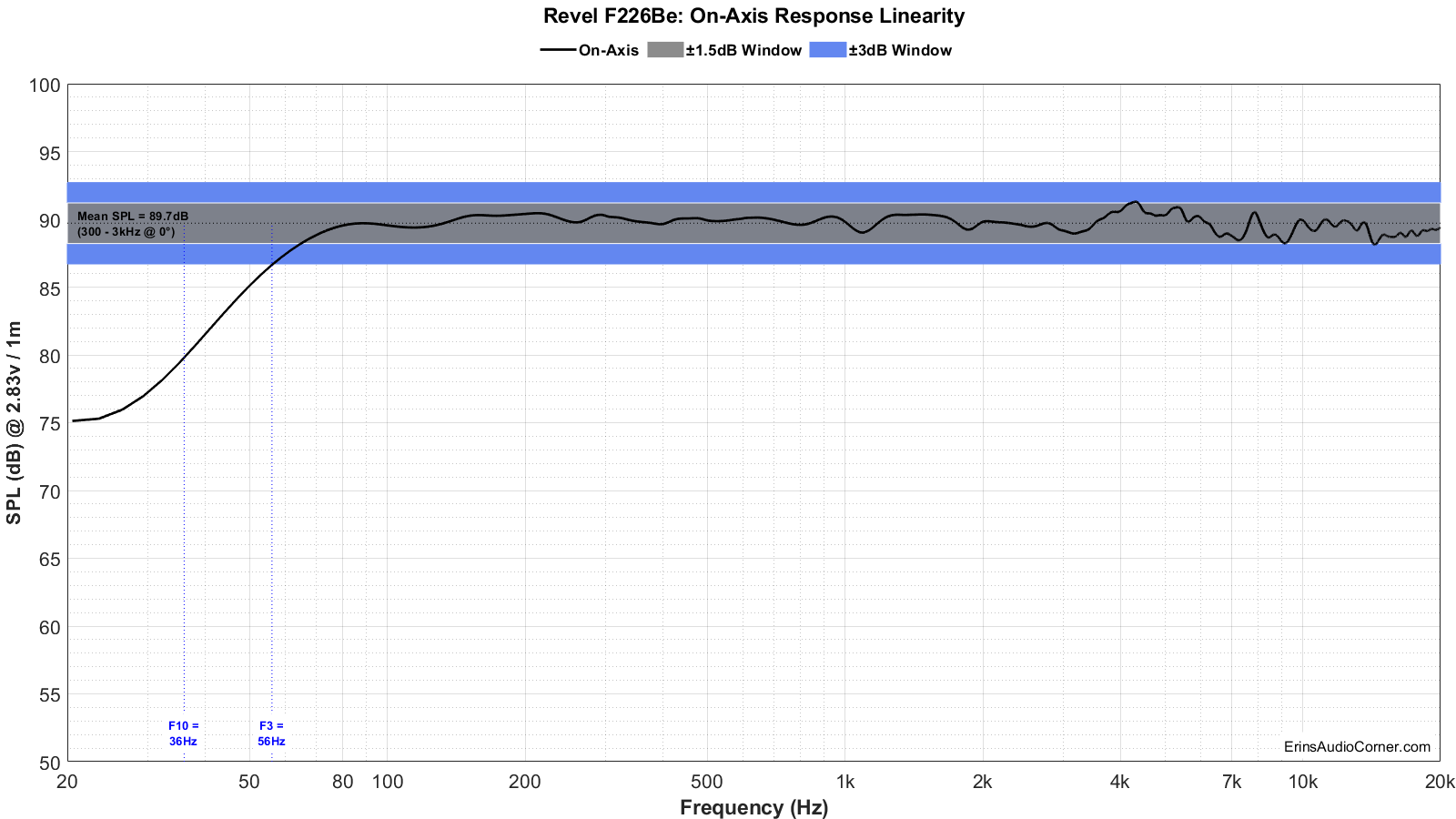
The mean SPL, approximately 89.7dB at 2.83v/1m, is calculated over the frequency range of 300Hz to 3,000Hz.
The blue shaded area represents the ±3dB response window from my calculated mean SPL value. As you can see in the blue window above, this speaker has a ±3dB response above 56Hz. Even better, a tighter window of linearity is provided in gray as ±1.5dB from the mean SPL and this speaker stays within this window above 65Hz. This is the most linear on-axis response I have measured from any speaker to date.
The speaker’s F3 point (the frequency at which the response has fallen 3dB relative to the mean SPL) is 56Hz and the F10 (the frequency at which the response has fallen by 10dB relative to the mean SPL) is 36Hz. This speaker has nice low frequency extension and may be adequate for many without a sub-woofer. However, I recommend the use of a subwoofer below 40-50Hz not only to provide additional low-frequency output for movies and music and additionally to both take the strain off this speaker (increasing dynamic range) as well as to spread some room modes (when using multiple subwoofers).
Below are both the horizontal and vertical response over a limited window (90° horizontal, ±40° vertical). I have provided a “normalized” set of data as well. The normalization simply means that I took the difference of the on-axis response and compared the other axes’ measurements to the on-axis response which gives the viewer a good idea of the speaker performance, relative to the on-axis response, as you move off-axis.
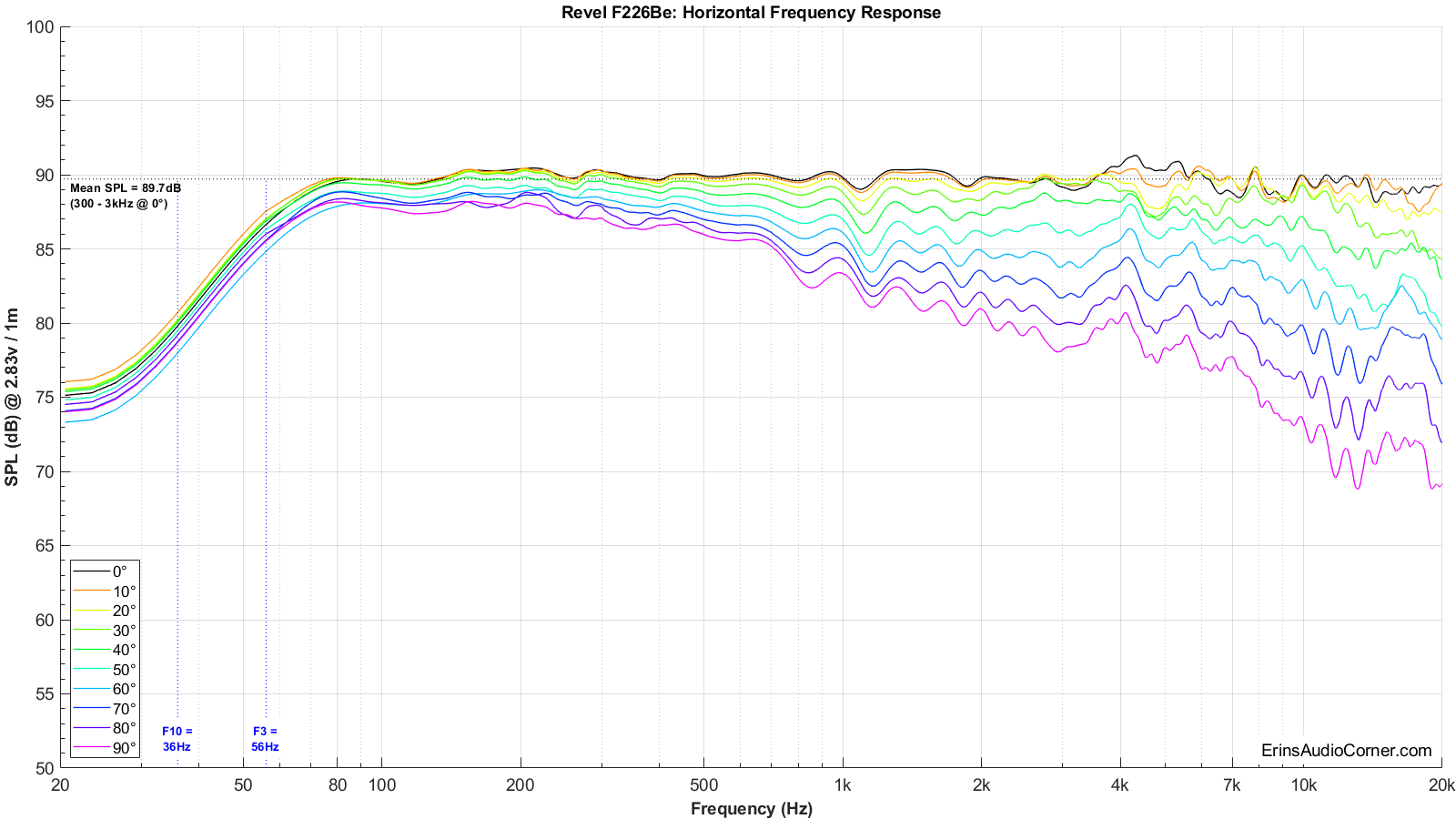
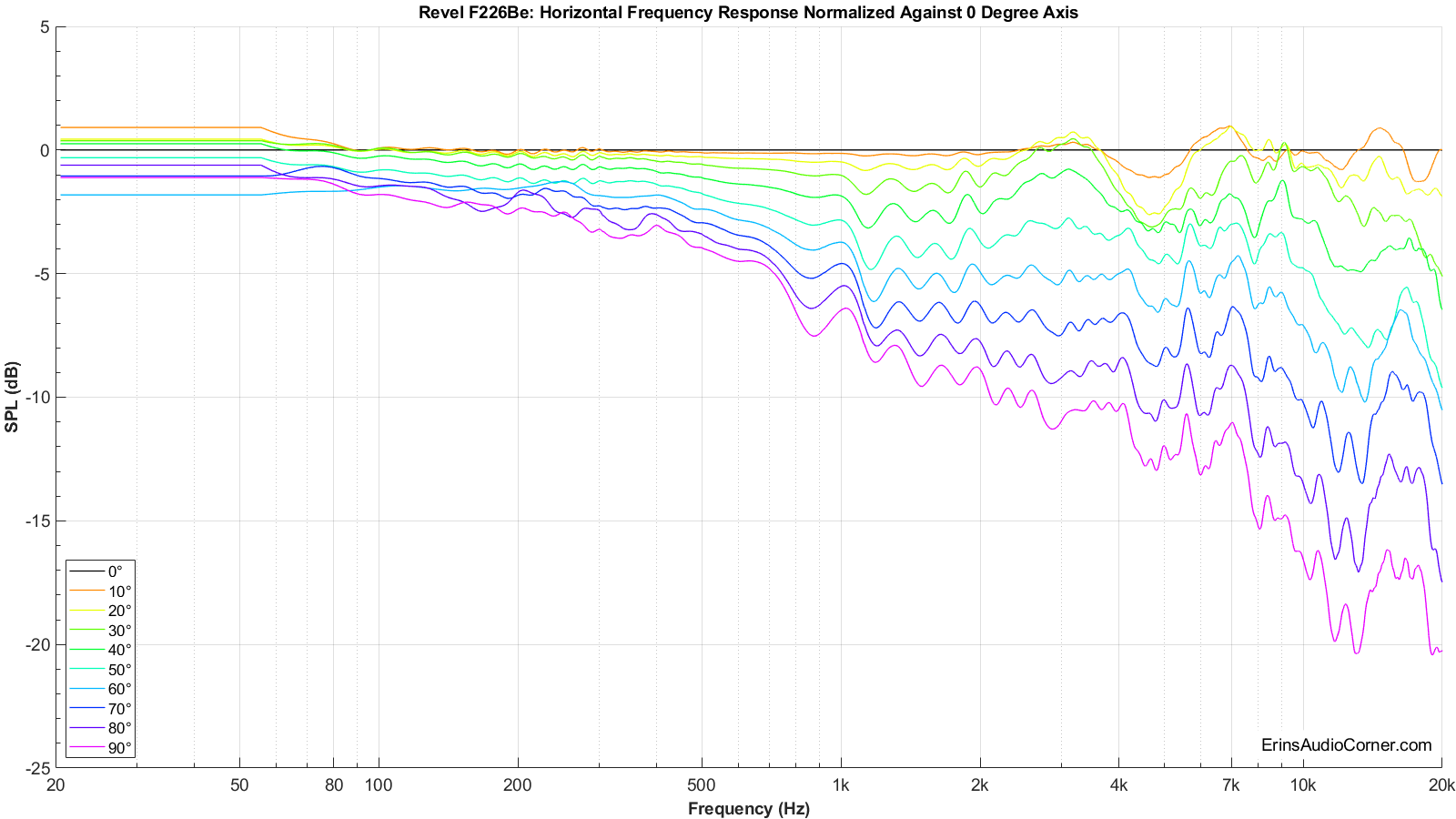
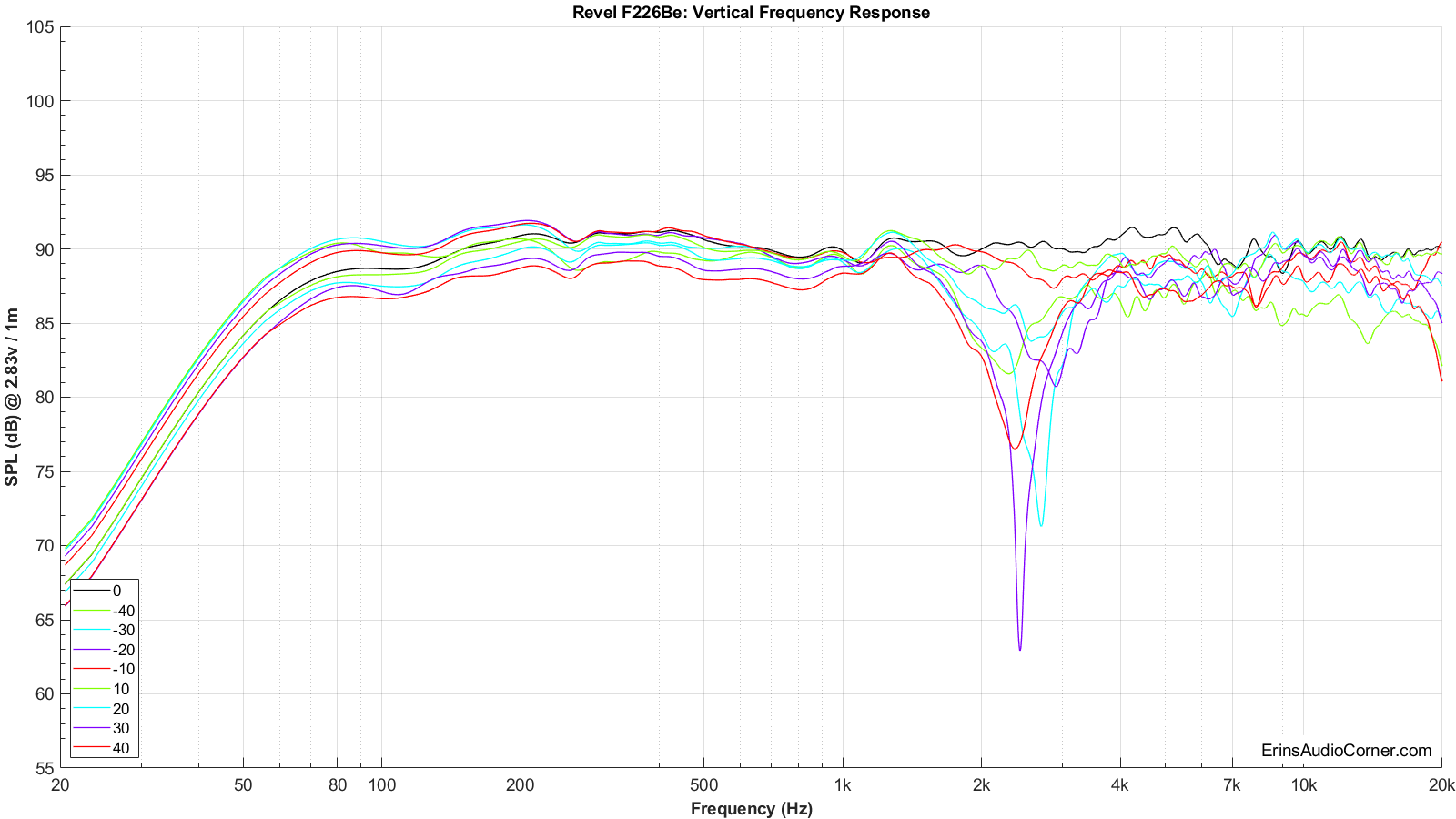
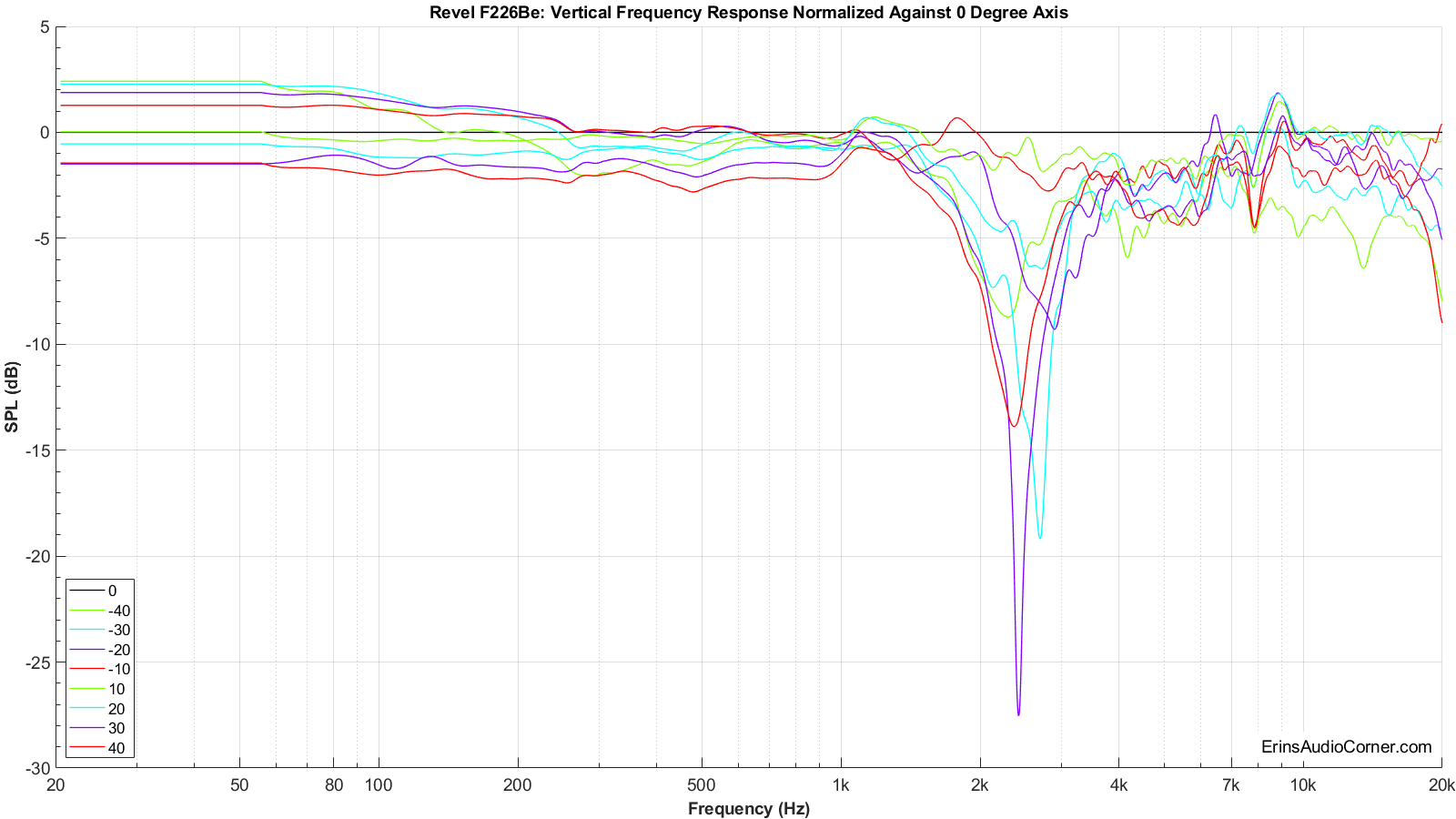
As I said above, the provided frequency response graphs were given with a limited set of data. I measured the response of the speaker’s vertical and horizontal axis in 10-degree steps over 360-degrees. Nearly 70 measurements in total are represented in my data. As you can imagine, providing all those data points in a single FR-type graphic below is a bit overwhelming and confusing for the viewer. A spectrogram is an alternate way to view this full set of data. This takes a 360-degree set of data and “collapses” it down to a rectangular representation of the various angles’ SPL. I have provided two sets of data: one set for horizontal and one for vertical. Each set consists of 2 graphics:
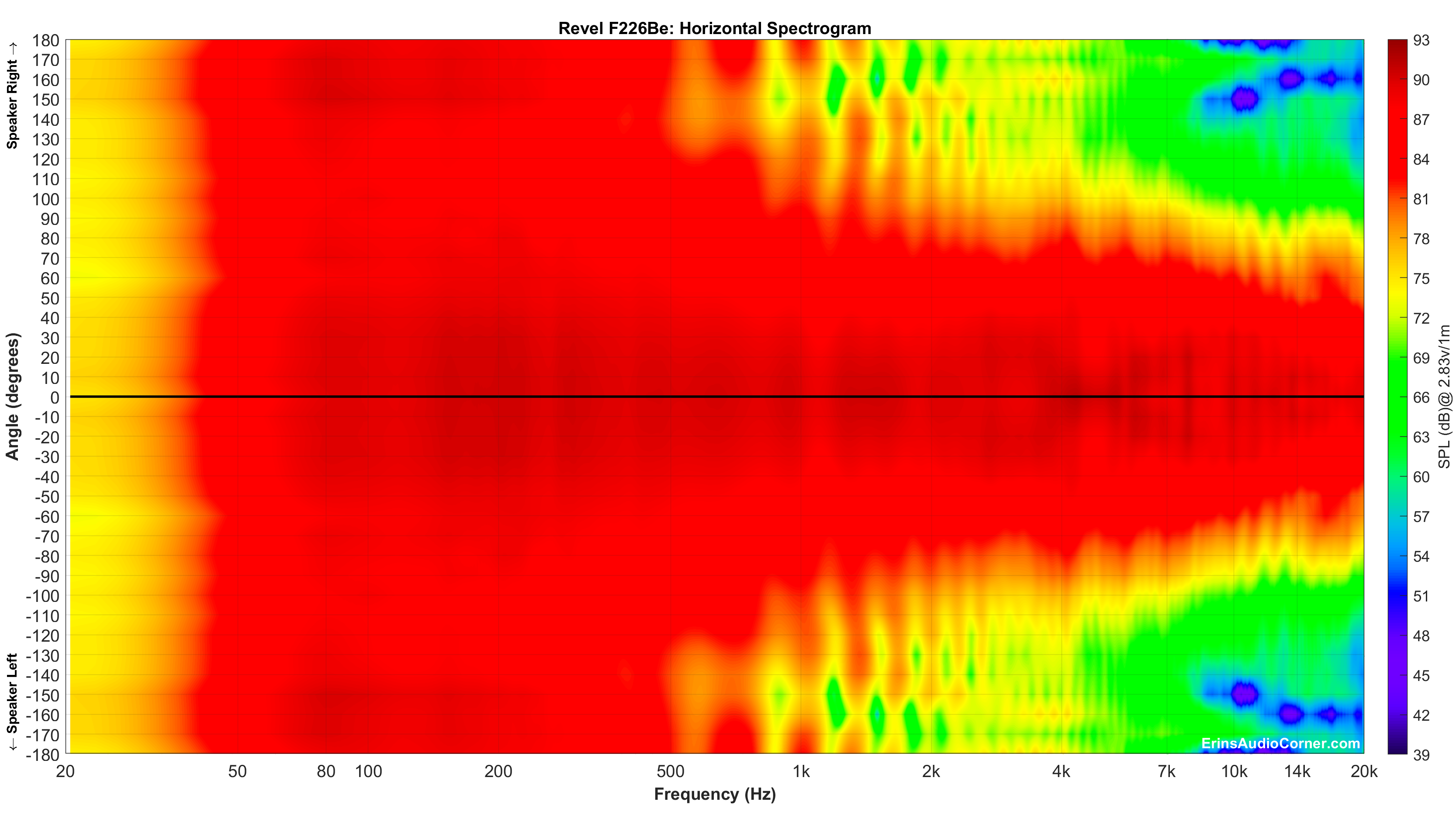
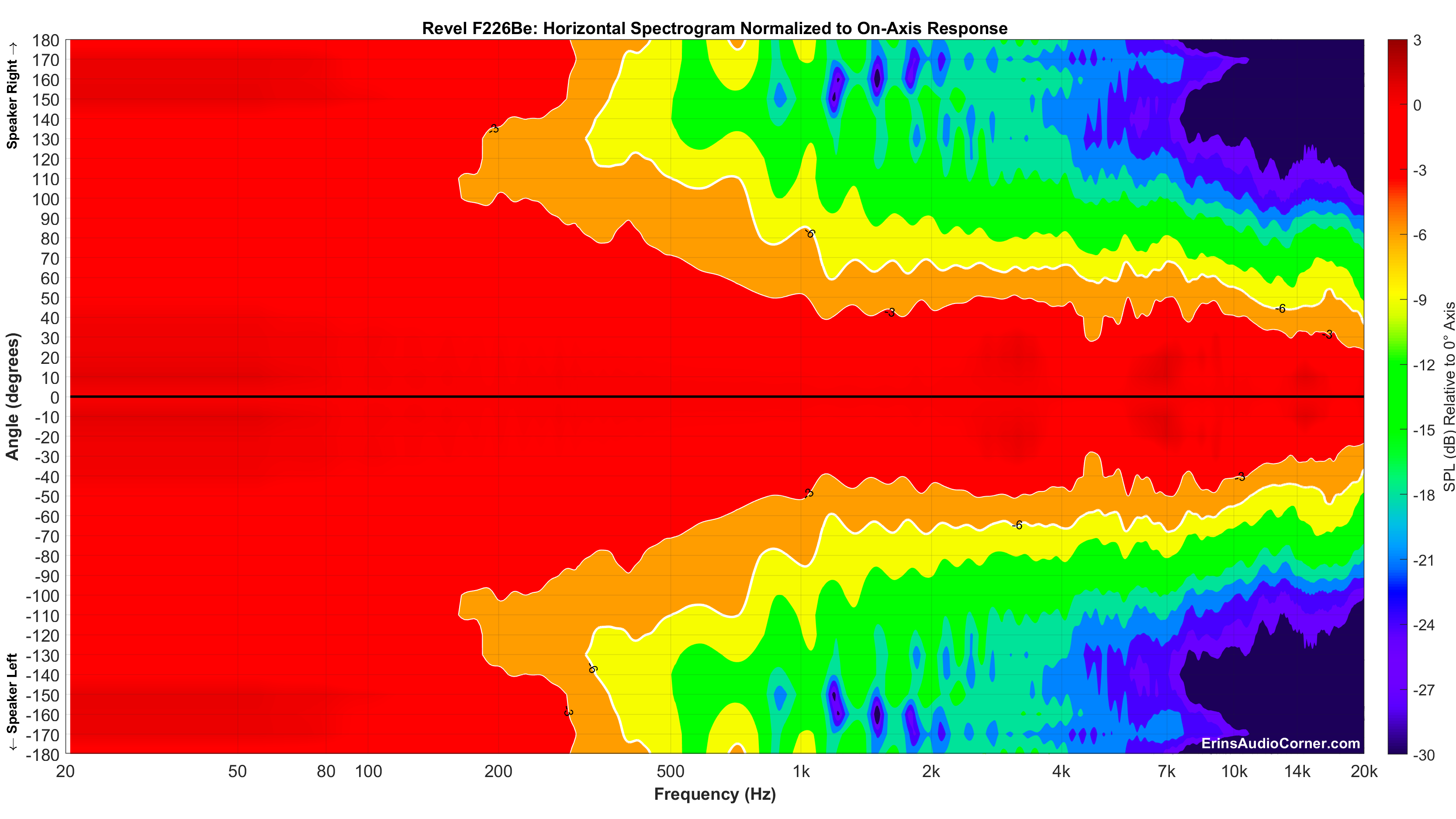
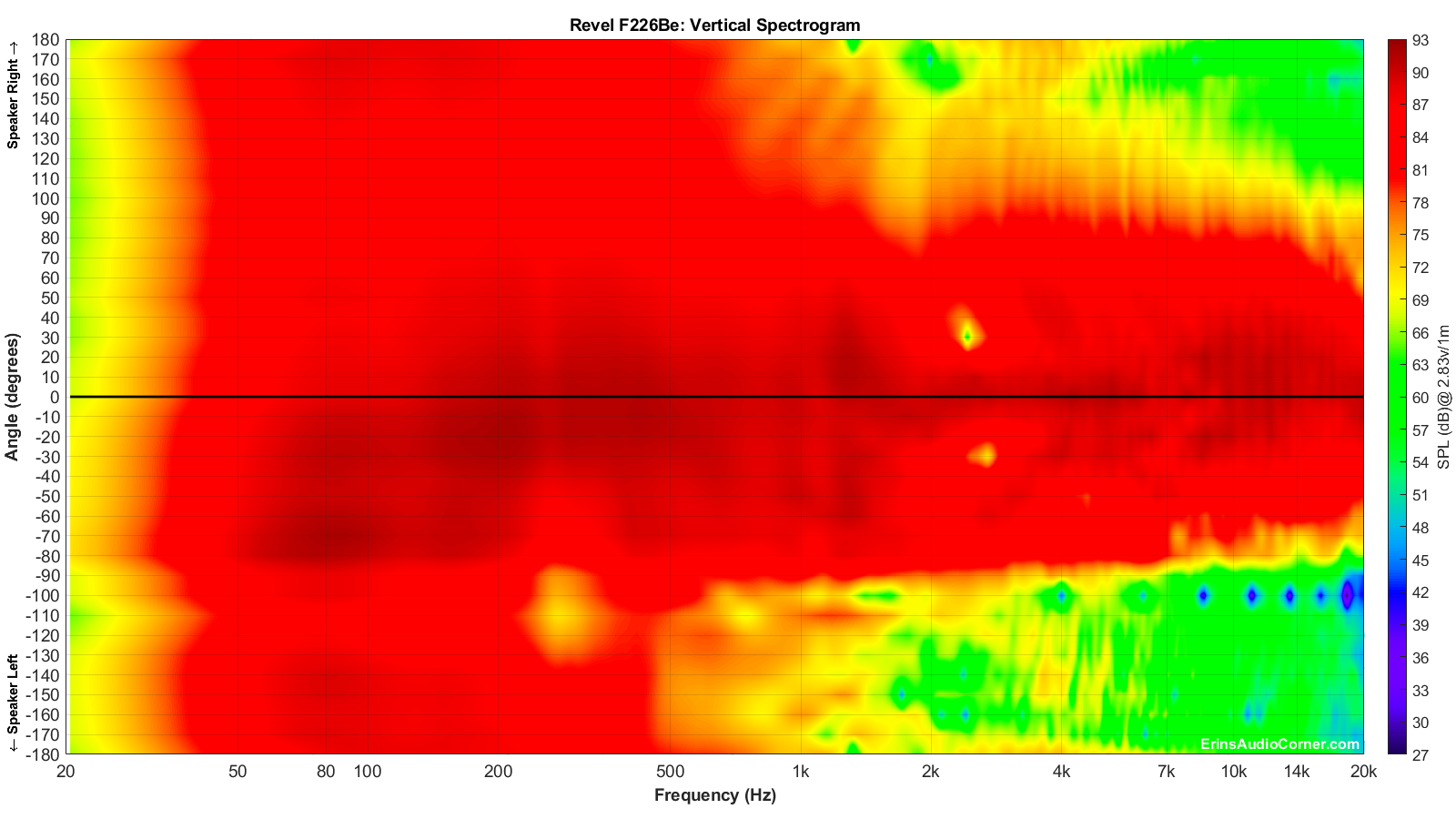
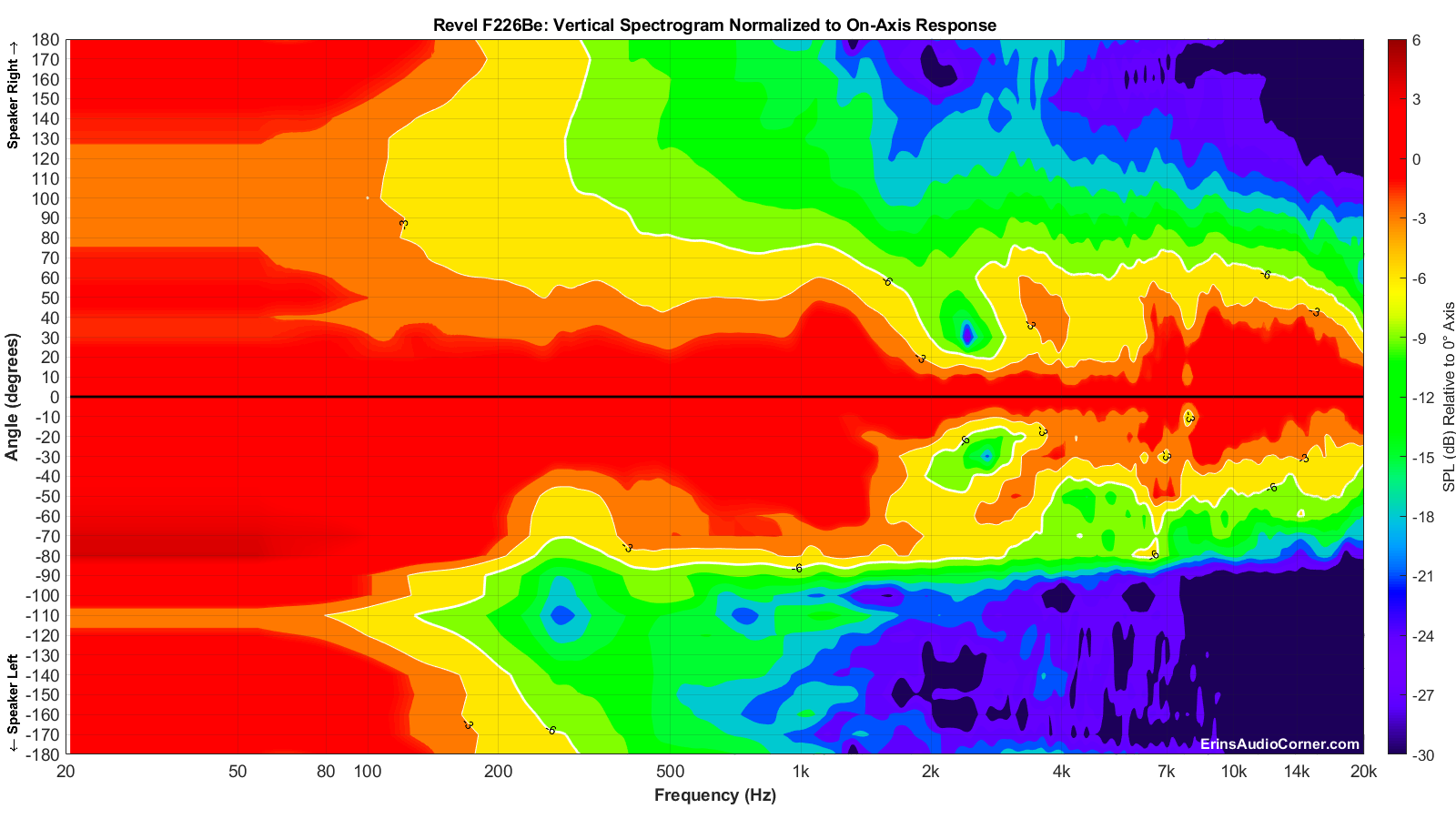
The above spectrograms are the standard way of providing directivity graphics by most reviewers. Some prefer not to normalize the data. Some prefer to normalize the data. Either way, it’s a useful visual to get an idea of the directivity characteristics of a speaker or driver.
However, these “collapsed” representations of the sound field are not very intuitively viewed. At least not to me. So, I came up with a different way to view the speaker’s horizontal and vertical sound field by providing it across a 360° range in a globe plot below. I have provided both an absolute SPL version as well as a normalized version of both the horizontal and vertical sound fields.
Note the legend provided in the top left of each image which helps you understand speaker orientation provided in my global plots below.
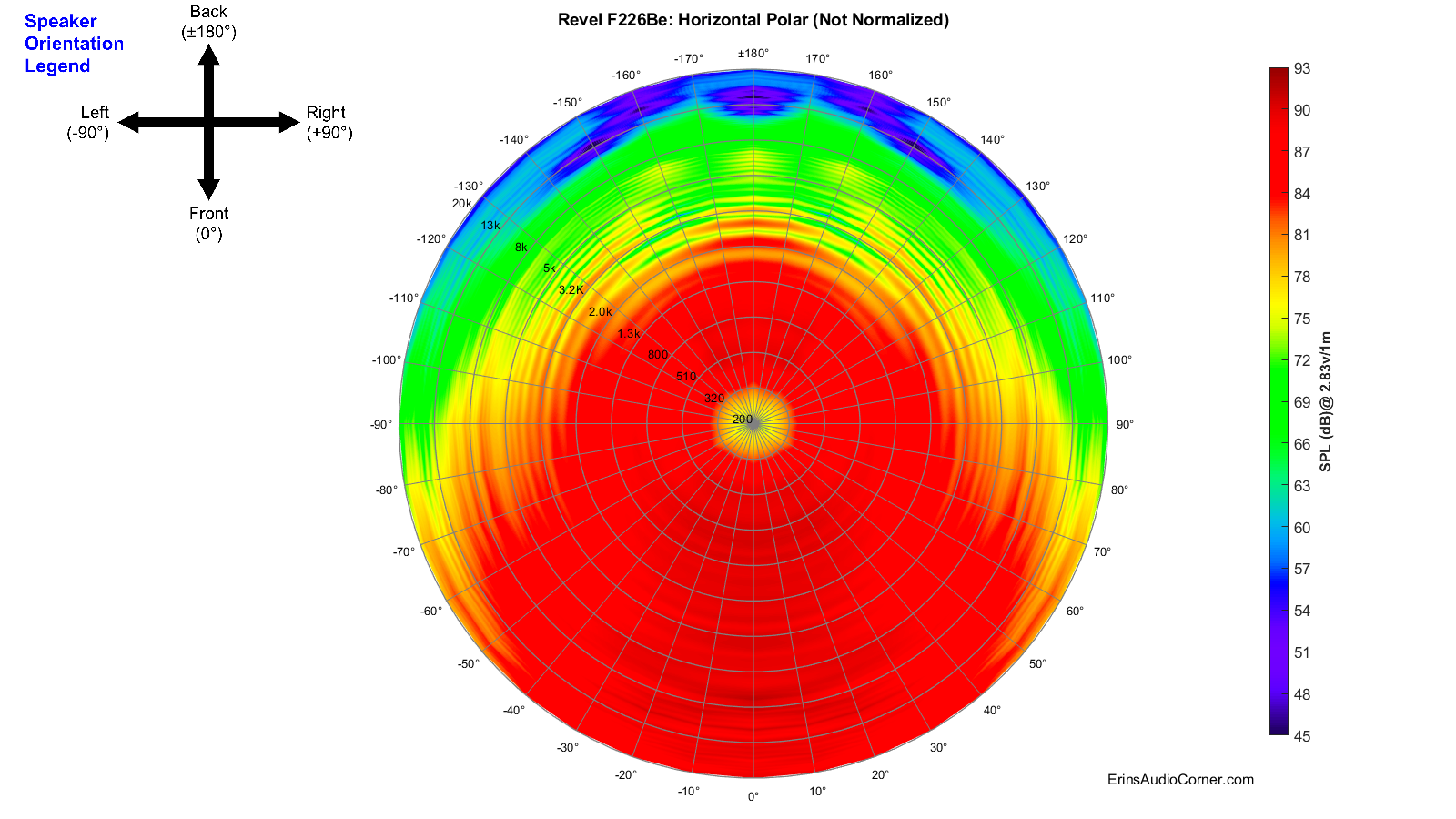
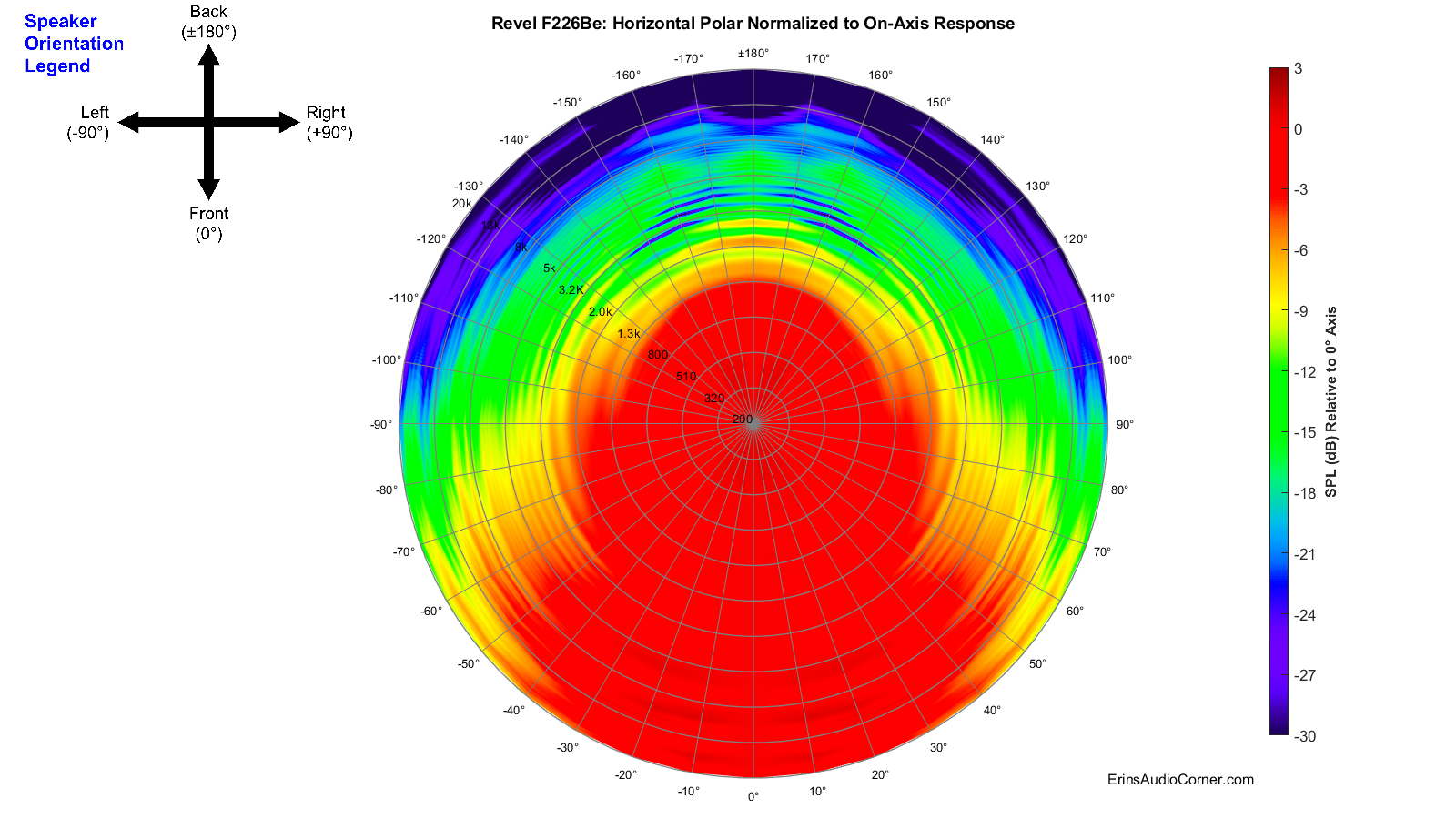
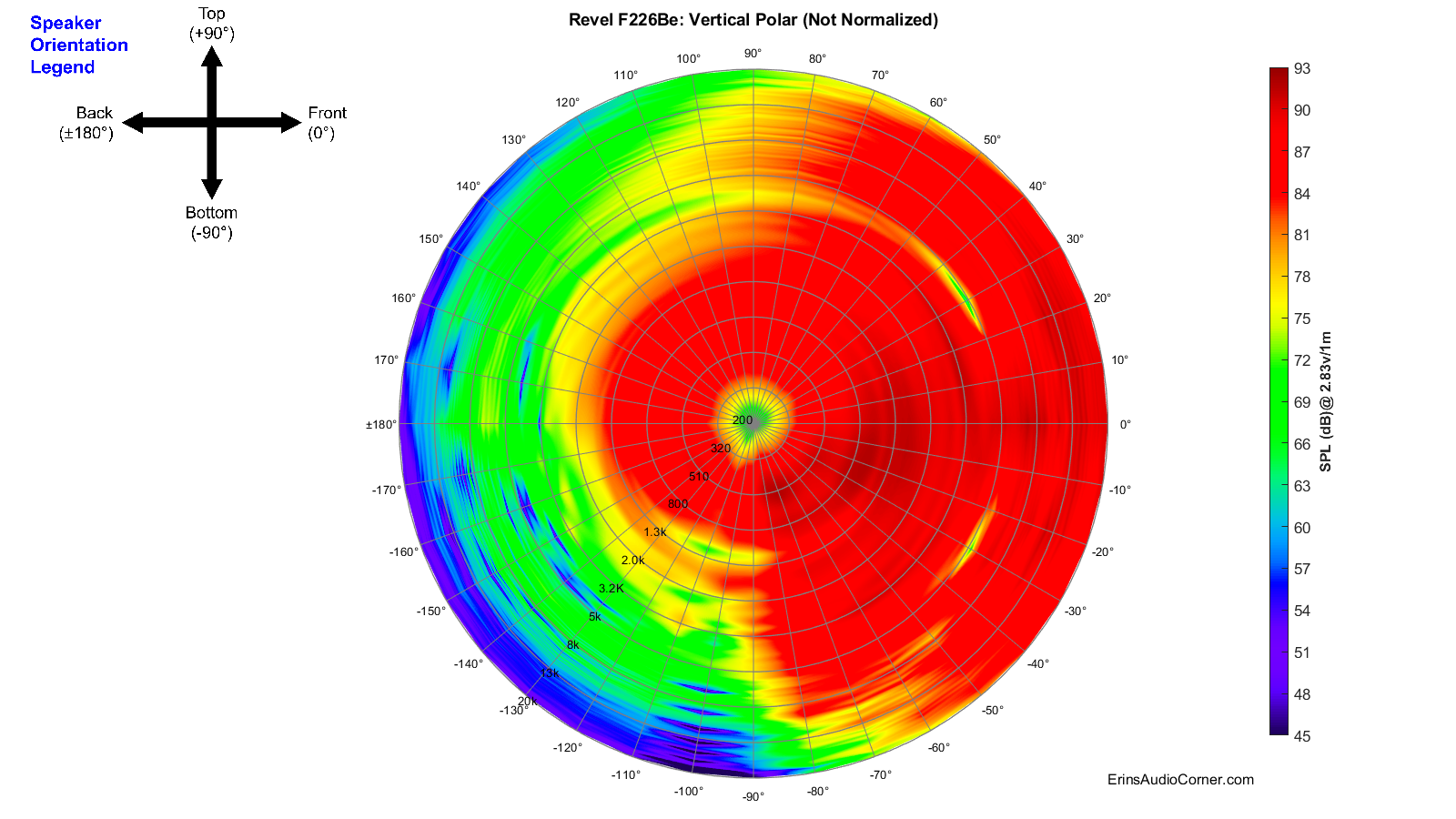
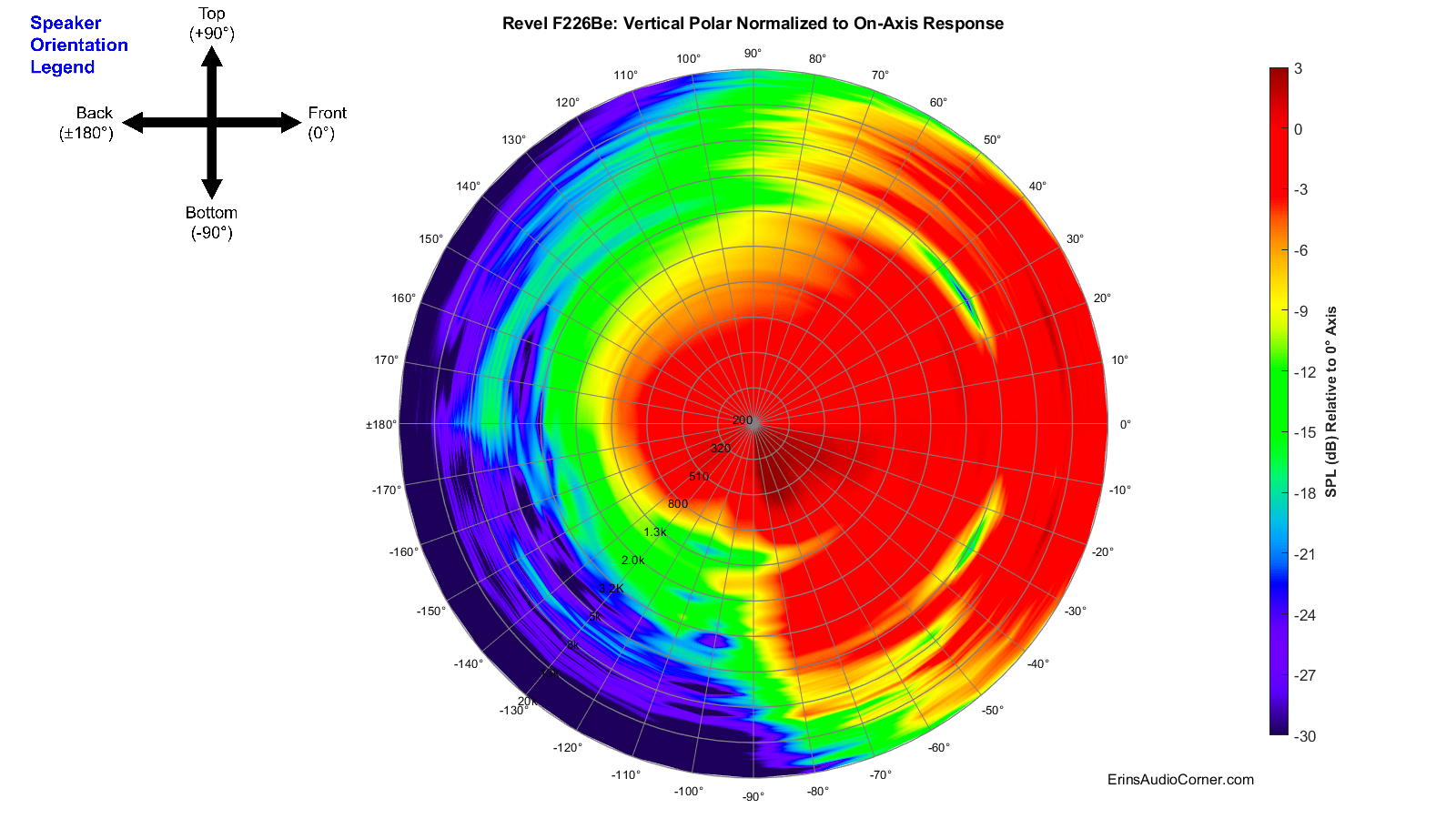
CEA-2034 (aka: Spinorama):
The following set of data is populated via 360-degree, 10° stepped, “spins” from vertical and horizontal planes resulting in 70 unique measurements. Thus, this is sometimes referred to as “Spinorama” data. Audioholics has a great writeup on what these data mean (link here) and there is no sense in me trying to re-invent the wheel so I will reference you to them for further discussion. However, I will explain these curves lightly and provide my own spin on what they mean (pun totally intended). Sausalito Audio also has a good write-up on these curves here. Furthermore, you can find discussion in Dr. Floyd Toole’s book “Sound Reproduction”. And, finally, here is a great video of Dr. Toole discussing the use of measurements to quantify in-room performance.
In short, the CEA-2034 graphic below takes all the response measurements (horizontal and vertical) and applies weighting and averaging to sub-sets and can help provide an (accurate) prediction of the response in a typical room. If there is a single set of data to use in your purchase decision, this is probably it.
Alternatively, click this arrow, if you want my quick take on what these curves mean without going to another site.
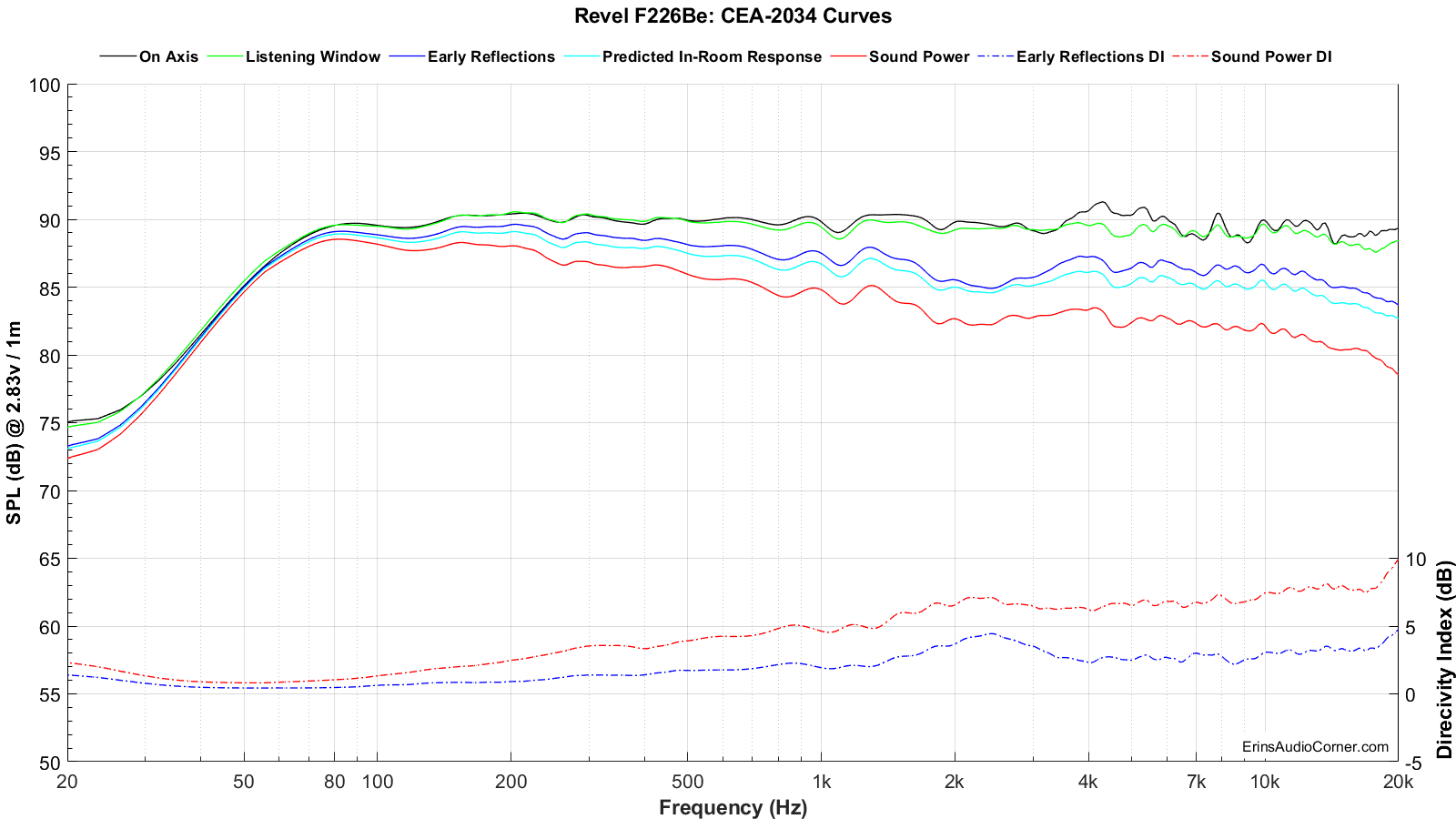
Below is a breakout of the typical room’s Early Reflections contributors (floor bounce, ceiling, rear wall, front wall and side wall reflections). From this you can determine how much absorption you need and where to place it to help remedy strong dips from the reflection(s). In this case, the listening room would benefit from having at least a carpeted floor and, if willing to do so, acoustic absorption on the ceiling between the listener and the speakers.
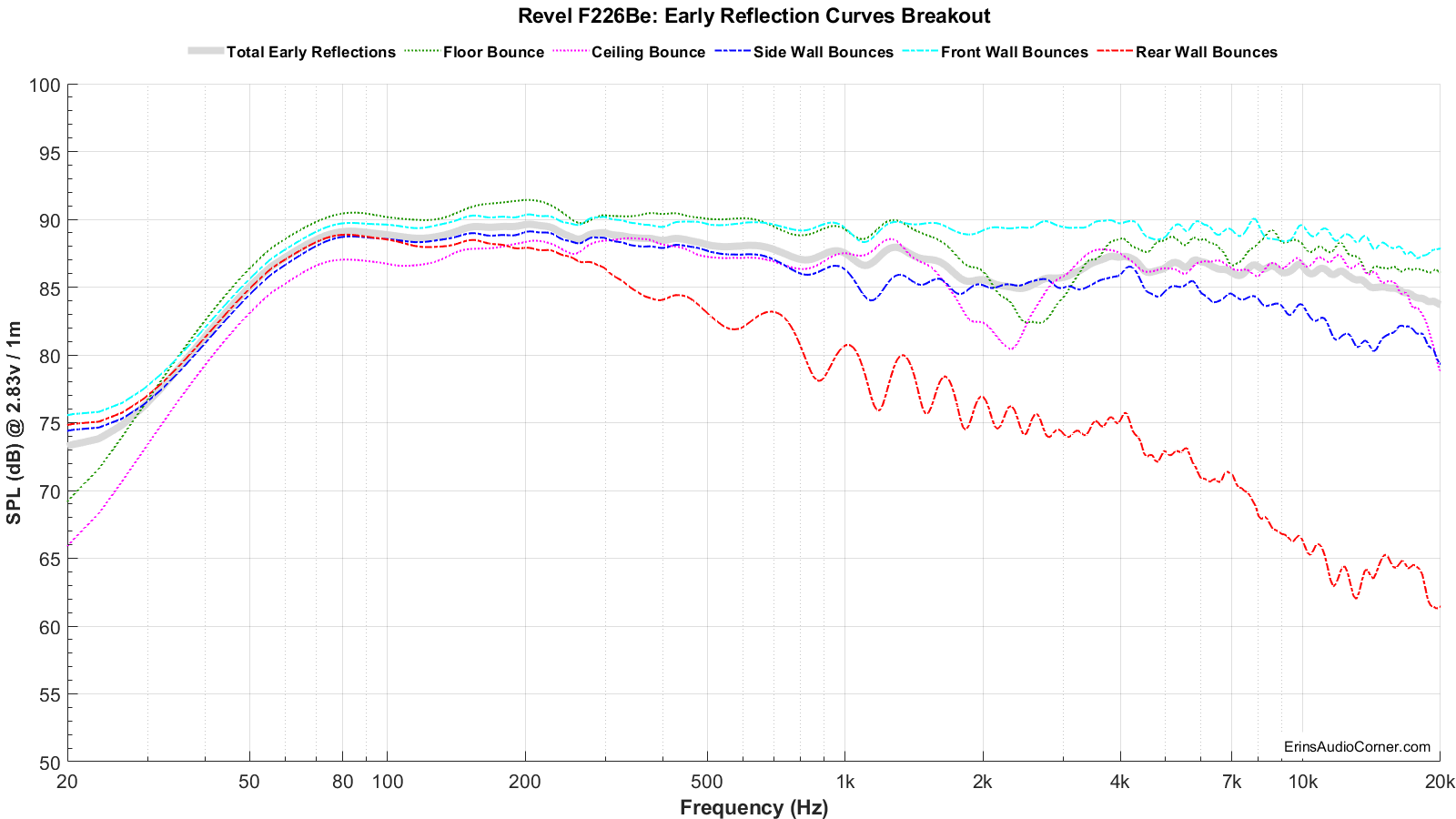
And below is the Predicted In-Room response compared to a general target curve equaling -1dB/octave.
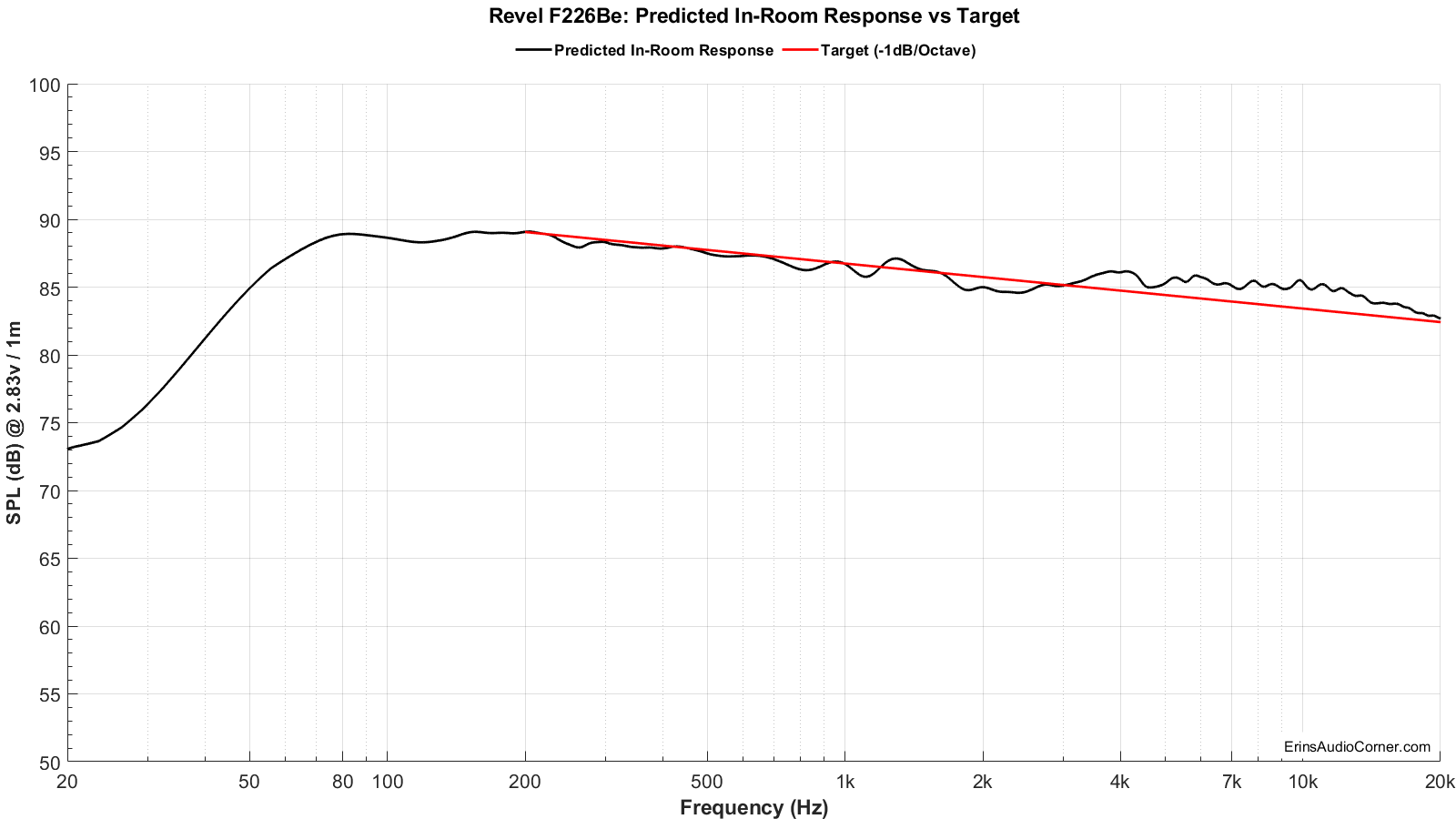
You may ask just how useful the above prediction is. Well, I’d be remiss for not delving in to that a little bit here. Please see my Analysis section below for discussion on this.
Harmonic Distortion:
Measurements were conducted at 2 meters ground plane using Klippel’s TRF module. Multiple output levels were tested to provide the trend of distortion component profiles and to provide a comparison against other drive units I have tested. The SPL provided is relative to 1 meter distance, averaged in the noted bandpass region.
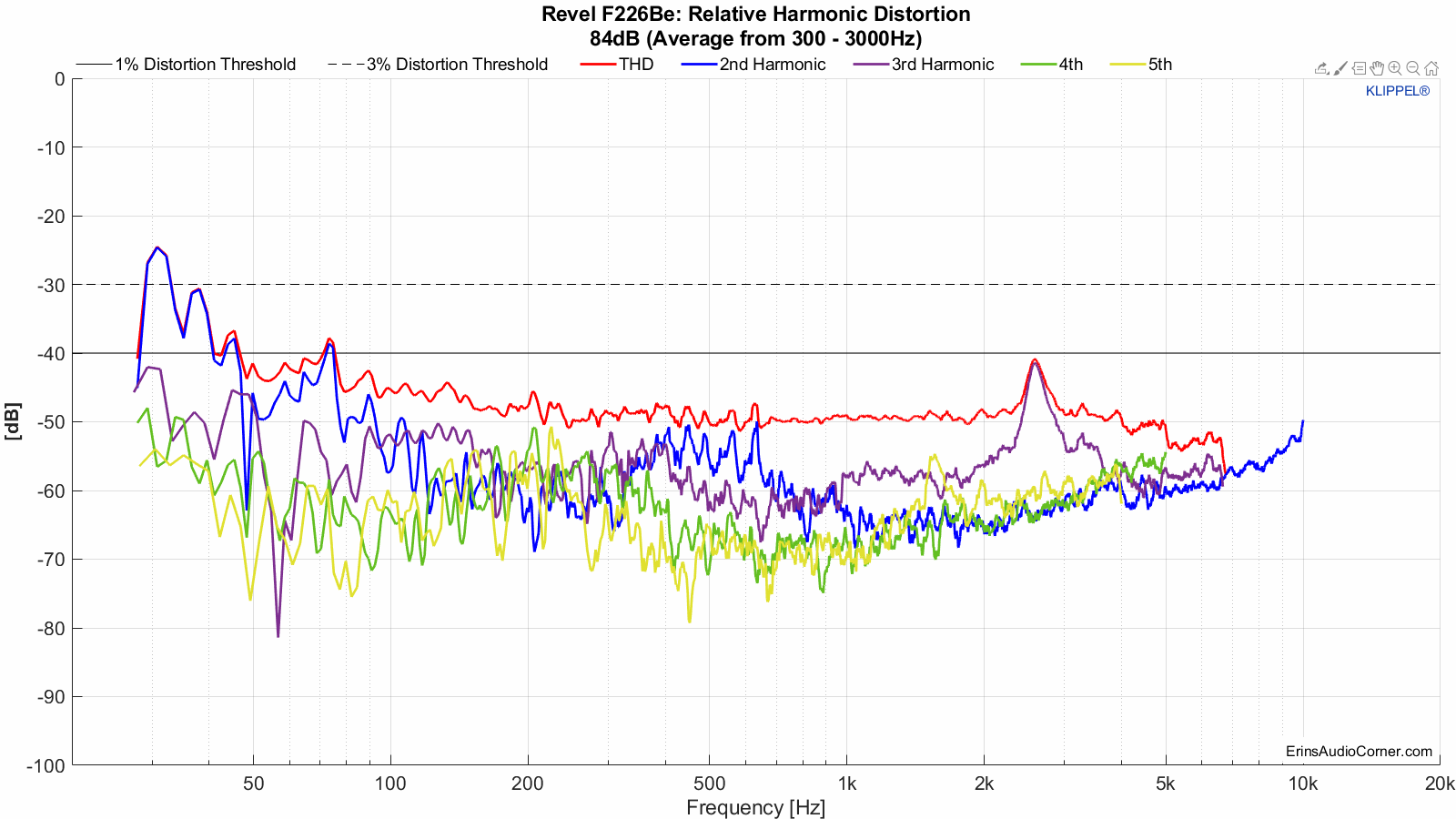
Maximum Long Term SPL:
The below data provides the metrics for how Maximum Long Term SPL is determined. This measurement follows the IEC 60268-21 Long Term SPL protocol, per Klippel’s template, as such:
The thresholds to determine the maximum SPL are:
This measurement is conducted once with a 20Hz to 20kHz multitone stimulus.
You can watch a demonstration of this testing via my YouTube channel:
Test 1: 20Hz to 20kHz
Multitone compression testing. The red line shows the final measurement where either distortion and/or compression failed. The voltage just before this is used to help determine the maximum SPL.
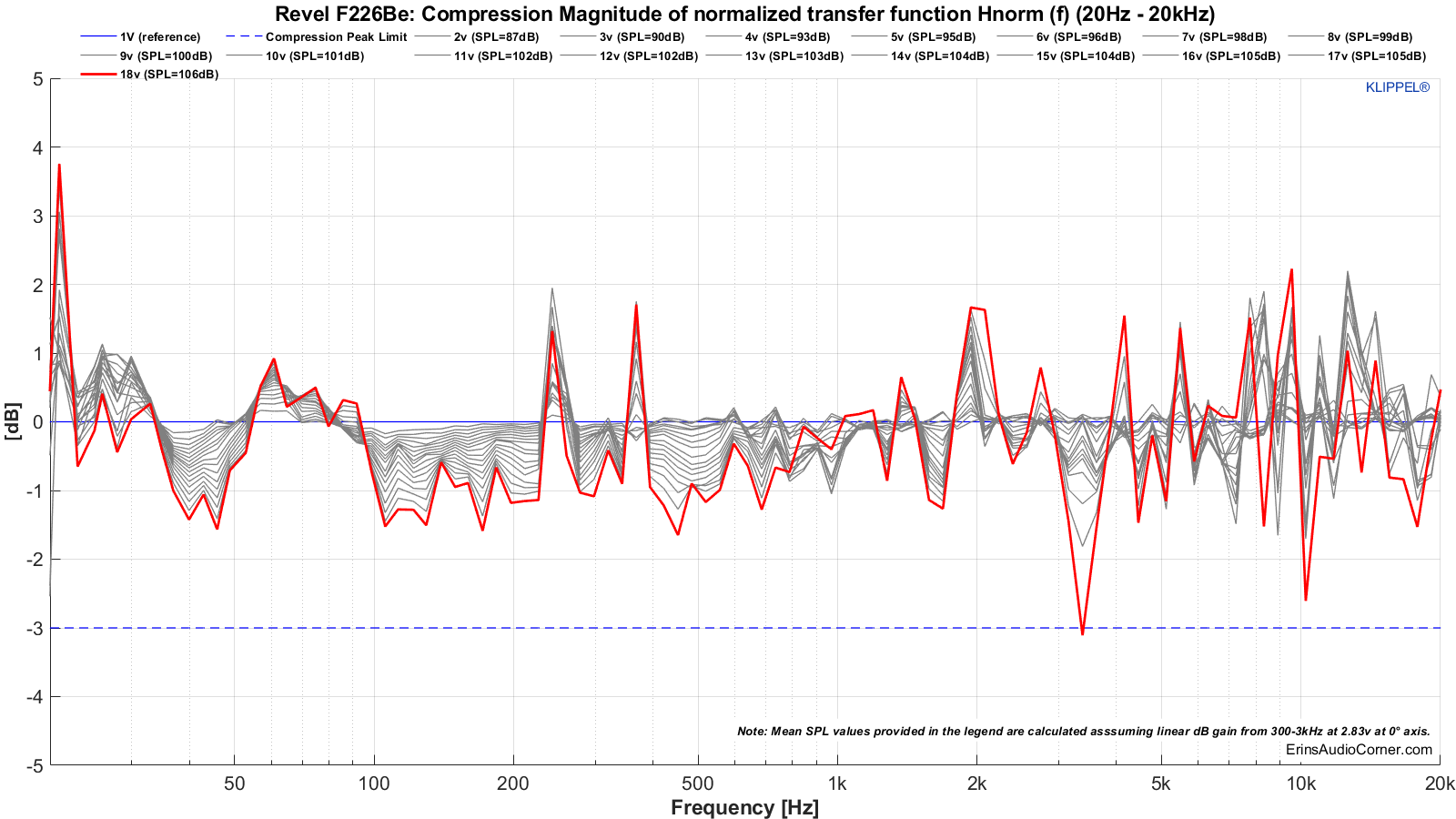
Multitone distortion testing. The dashed blue line represents the -20dB (10% distortion) threshold for failure. The dashed red line is for reference and shows the 1% distortion mark (but has no bearing on pass/fail). The green line shows the final measurement where either distortion and/or compression failed. The voltage just before this is used to help determine the maximum SPL.
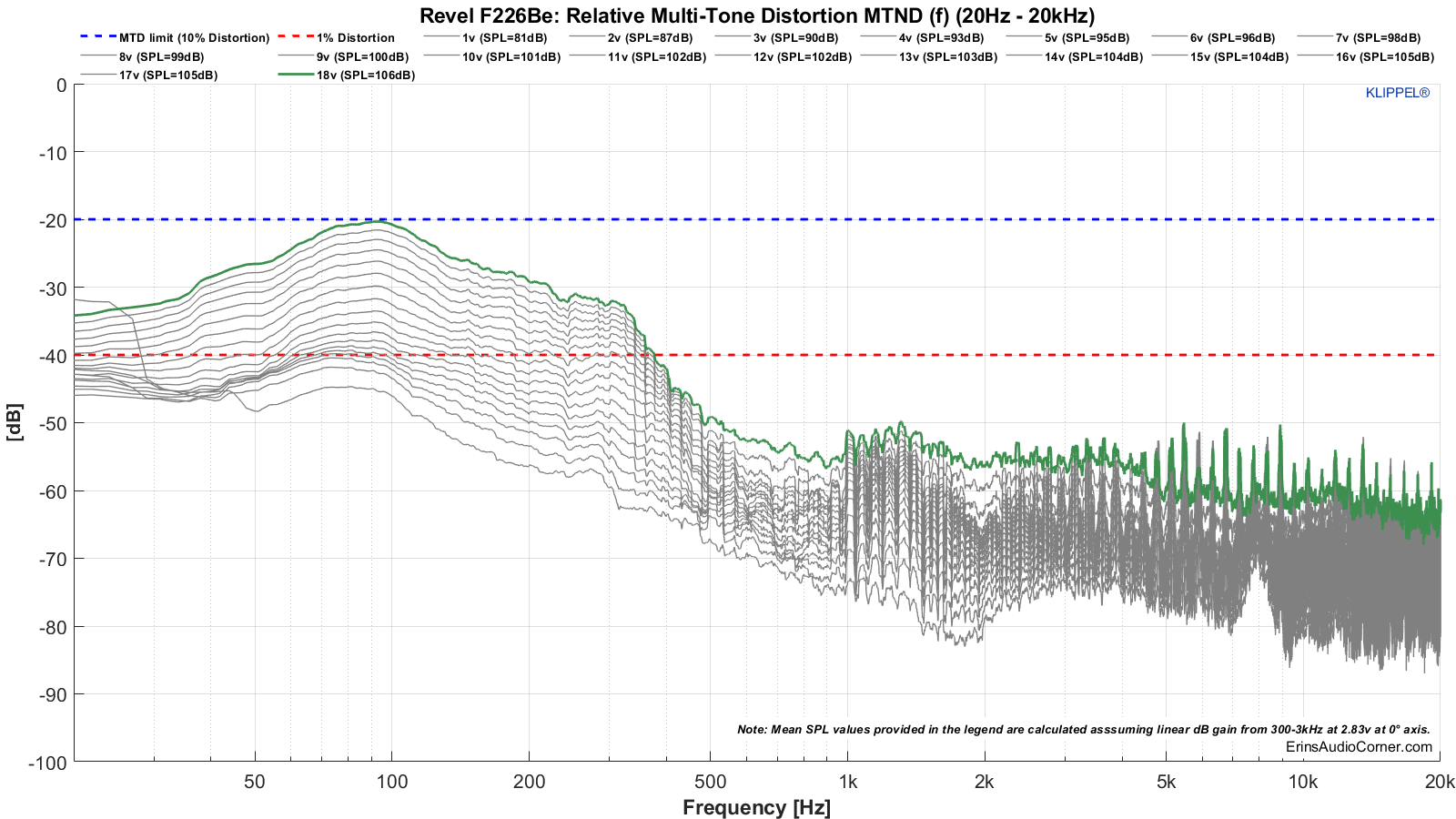
The above data can be summed up by looking at the tables above but is provided here again:
Extra Measurements:
Nearfield measurements.
Mic placed about 0.50 inches - relative to the baffle - from each drive unit and port. While I tried to make these as accurate in SPL as I could, I cannot guarantee the relative levels are absolutely correct so I caution you to use this data as a guide but not representative of actual levels (measuring in the nearfield makes this hard as a couple millimeters’ difference between measurements can alter the SPL level).
The singular nearfield woofers’ results measure lower in level but remember, they will sum acoustically to be about 3dB higher which would match their combined SPL with that of the midrange. Therefore, the crossover would match the specified crossover region of about 260Hz.
The midrange to tweeter crossover is specified at 2.1kHz which is in-line with what the nearfield measurements would otherwise suggest.
Notice how there is no resonance in the nearfield measurements. Not from the drive units nor the port. It is not at all unusual to see port resonance or woofer resonance outside the crossover on lesser speakers; these issues tend to creep up as distortion (linear and non-linear) in the speaker evaluation. However, there is none of that observed in this speaker via the nearfield measurements. Revel states their use of Deep Ceramic Composite (DCC) Cone Midrange and Woofers “provide constrained layer damping that push cone breakup modes outside of the passband allowing the driver to maintain ideal pistonic motion throughout its range". The below data backs that up.
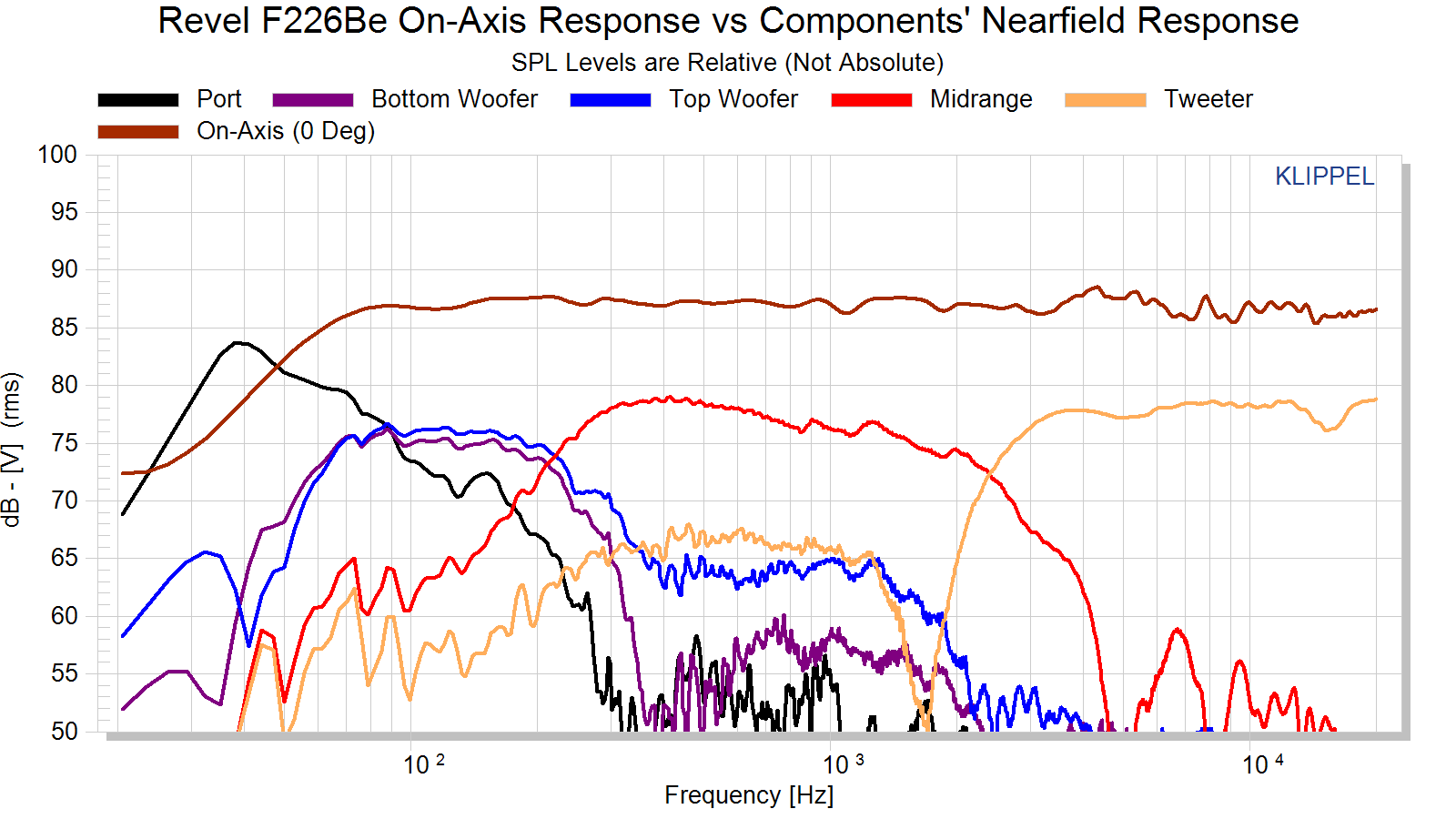
Step-Response.
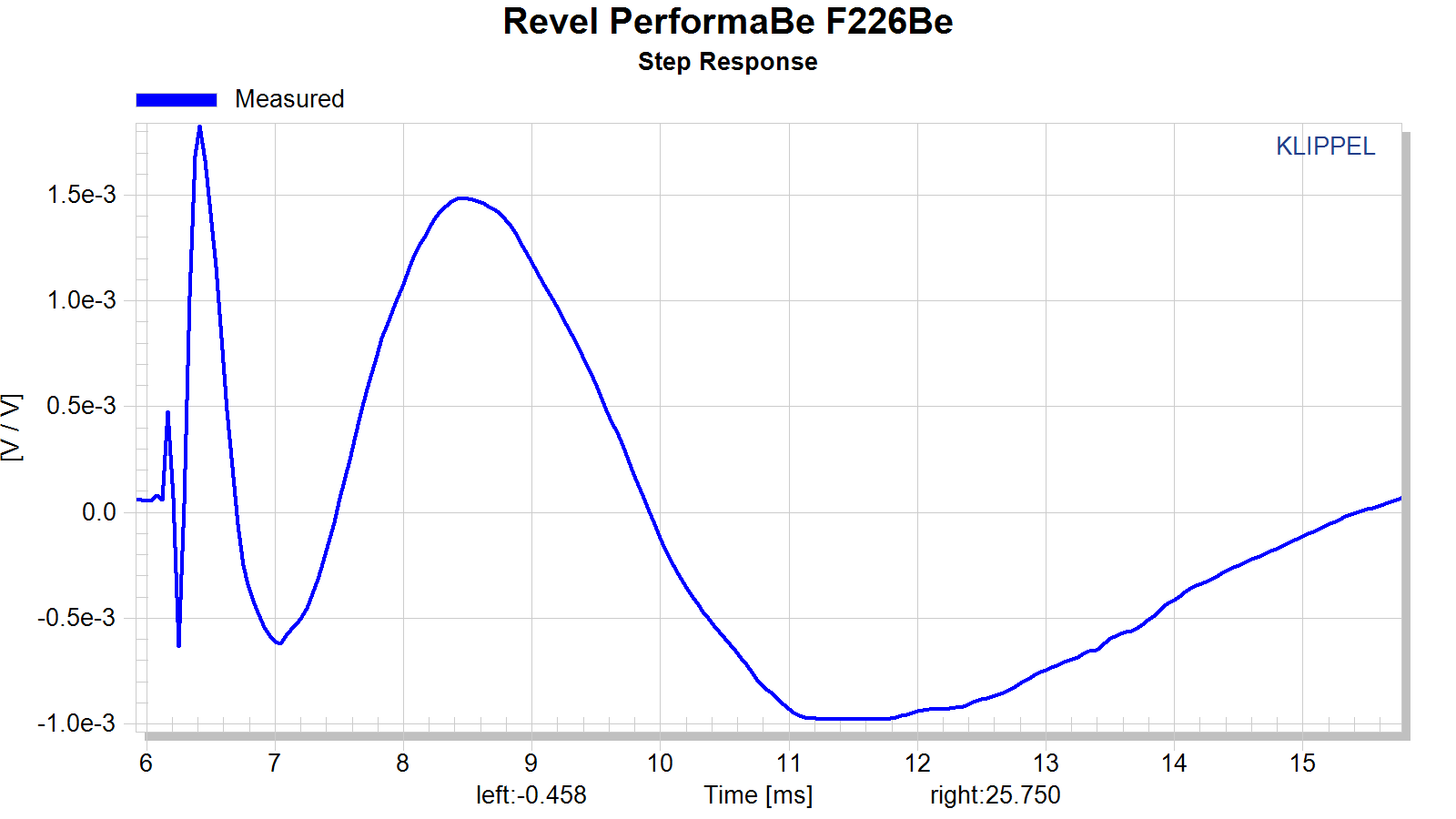
Objective Data Analysis/Evaluation:
Frequency Response:
Subjective Evaluation:
Now that we have gotten through all the data, let’s talk about what I heard!
I listen to speakers in two different rooms: my home theater room and my living room. I have provided a layout of the home theater below. And below that is a picture of the speakers set up in my living room. This gives you an idea of the actual environments these were auditioned in.
Home Theater layout:
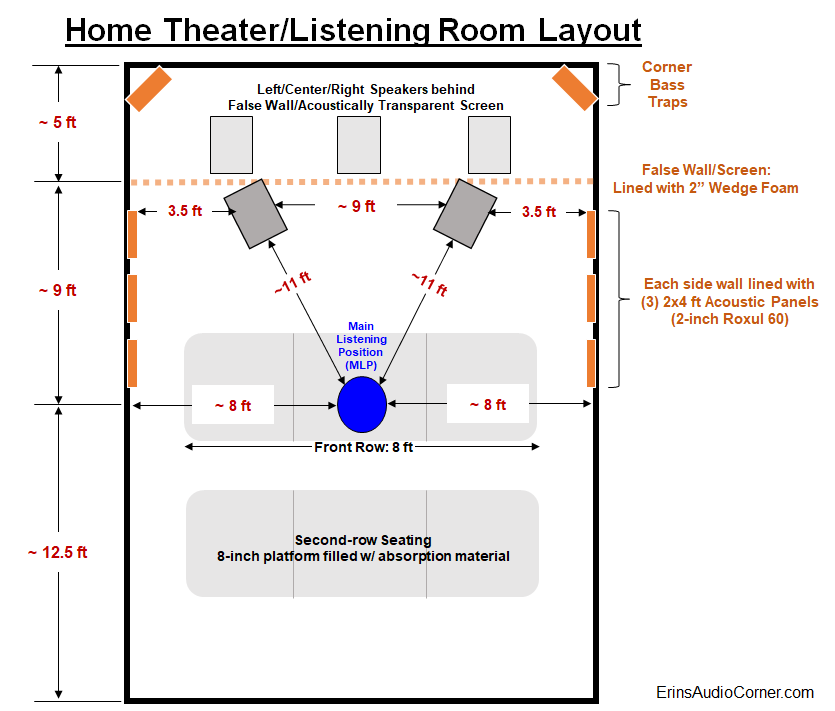
Per the illustration, I built a false wall and used an acoustically transparent screen with speakers behind it. The wall is only 2x4's; no panels of wood or anything. Just a skeleton of a wall to give me something to attach the screen and acoustic treatment to. There is 2-inch wedge foam affixed to the 2x4 studs and between the false wall and back of the room are the front speakers (L/C/R & 18-inch subwoofers).
Living Room setup:
Happy Halloween!!!!
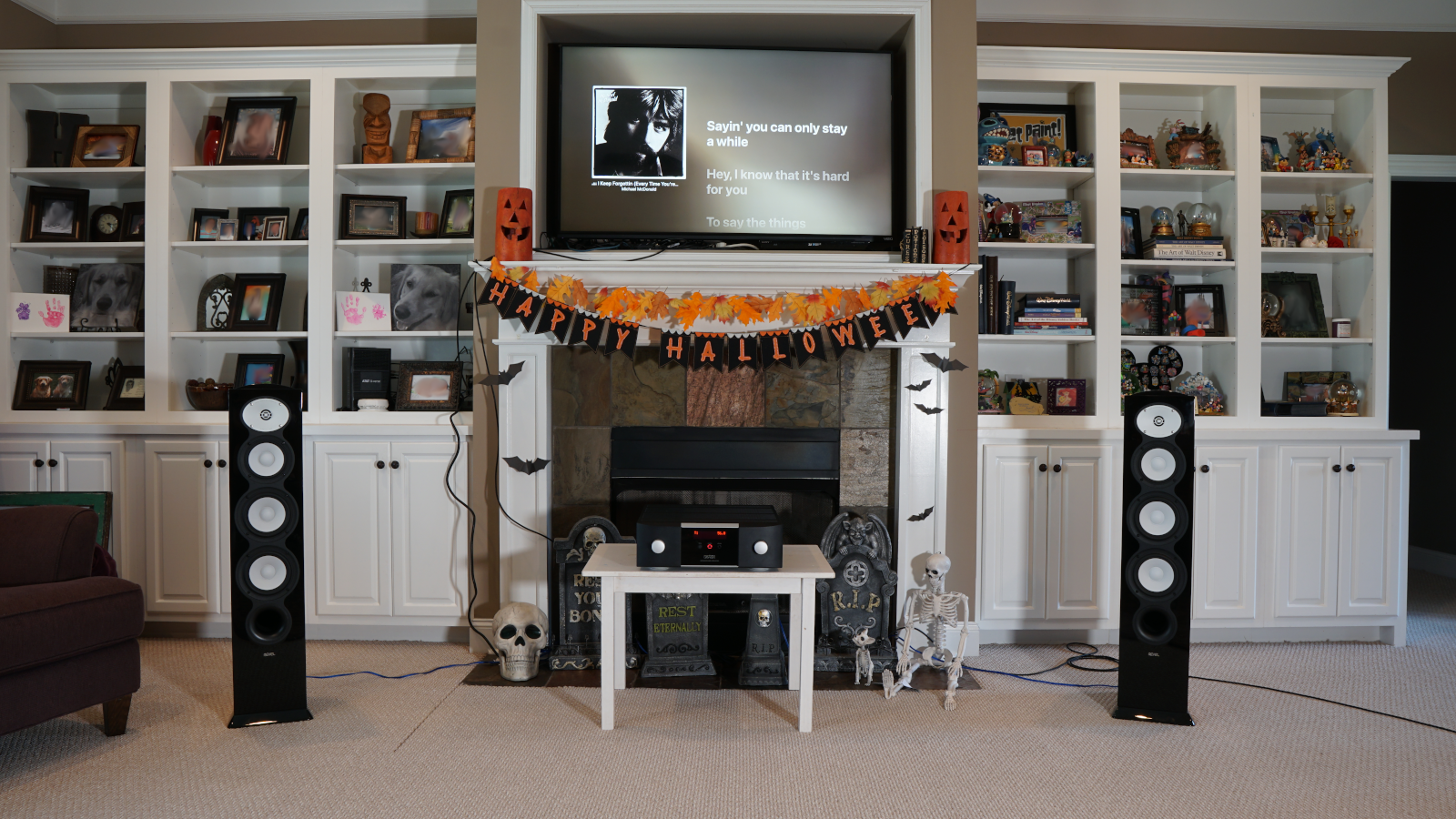
Subjective Analysis Setup:
I initially listened to these speakers and made my subjective notes before I started measuring objectively. I did not want my knowledge of the measurements to influence my subjective opinion. This is important because I want to try to correlate the objective data with what I hear in my listening space in order to determine the validity of the measurement process. I try to do a few listening sessions over a couple days so I can give my ears a break and come back “fresh”.
My demo music:
I auditioned these speakers numerous times over the span of a few weeks. While the list below is my primary auditioning music, I ultimately listened to many, many more tracks spanning various genres.
<see website review>
Below is the measured in-room response at the main listening position (MLP) of my Home Theater (HT) in red and my Living Room (LR) in blue both compared against the predicted in-room response (purple). These were taken via the moving microphone average, covering the space of about 1 cubic foot in the MLP. The measurements/prediction below do not have EQ applied.
You can see the prediction follows pretty reasonably to what is measured in the seated position in both rooms, aside from the typical lower frequency modal issues caused by the rooms themselves. Two completely different listening setups yielded a similar response that both match the predicted in-room response borne from the spinorama data. This proves that the anechoic data and means to provide a predicted room response result in a very accurate prediction.
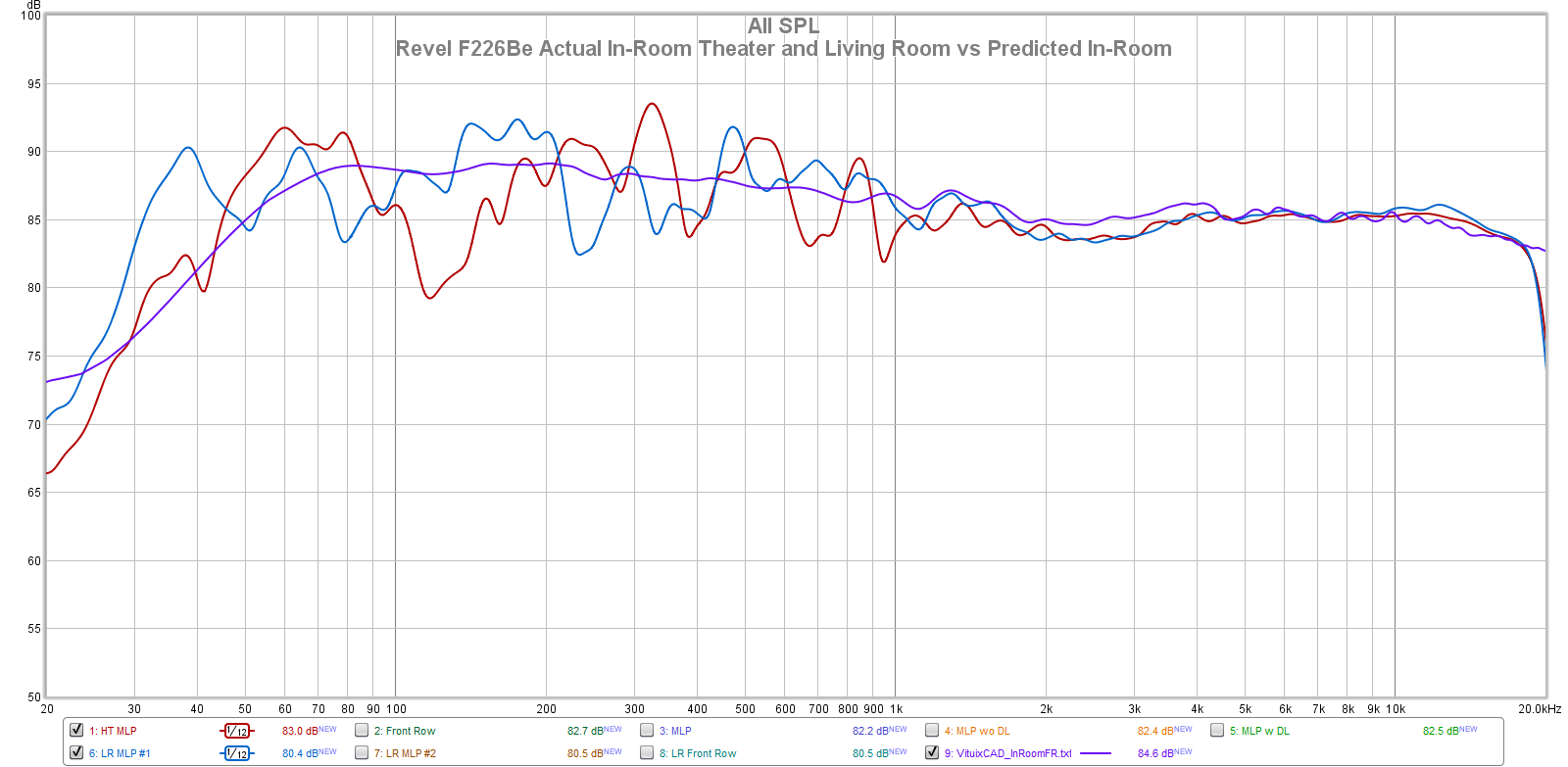
Here are my key notes and takeaways from my audition:
Bottom Line
In my experience, the Revel PerformaBe F226Be is a “jack of all trades” speaker. It can fill the role of background music when you are having a conversation or when you’ve got Motley Crue cranked up while you rush to clean the house before your significant other gets home from work. It wears the glass slipper of upper echelon audiophile-enjoyment with ease. It plays at low volume levels and high volume levels while providing the same sense of enjoyment and involvement thanks to its ability to provide low level dynamics. It was a true treat to be able to listen to my music collection at a more reasonable volume, resulting in no ear fatigue over the span of hours. As opposed to feeling the need to turn up the volume to get some of those “dynamics” (i.e., bass impact) thus causing ear fatigue 20 to 30 minutes in to my listening session. I … revel’ed … in this luxury. (I wouldn’t resist the pun)
Oh, and if you are wondering if this plays (insert your favorite genre of music here) well, the answer is: yes. It’s not a one-trick pony. No speaker should be. Unfortunately, some speakers are.
While I certainly enjoyed this speaker in my home theater for tunes and movie watching, the F226Be is, in my opinion, the perfect size for a floorstanding speaker in a living room as well. It isn’t so large as to consume the living space like a larger speaker (for example, the bigger brother F328Be), even once you have set it out from the walls. It also isn’t so skinny to not look like a worthy adversary in the bass department. And, let’s face it, there is a lot of psychoacoustics-related expectation versus actual performance when you are sitting and looking at a speaker. This speaker does a great job of checking the aesthetics, form and function boxes.
To be honest, I have tried quite hard to find faults in this speaker. It is much easier for me to do that and correlate the subjective “bad” with objectively bad data. That is why most of my reviews have been quite easy to write; because I could find at least a few negatives about some otherwise great speakers. But for all my efforts, I couldn’t find a single complaint with the F226Be. Sure, it would be great if it extended down to 20Hz with authority. But realistically, a speaker capable of that would be much larger than this one and I’d still likely use separate subwoofers just to help spread the load not only mechanically speaking but acoustically as well. A room benefits from multiple subwoofers acoustically. On the topic of bass, while I did not hear any strain from this speaker when pushing it to high output levels without a crossover, the fact is it does roll off below 50Hz and a subwoofer is recommended. My in-room response showed further lower frequency extension than this. I used a 12-inch subwoofer to help fill in below 50Hz and was incredibly happy with the results. Therefore, if I were to own this speaker, I would purchase a subwoofer to complement the low end for the above mentioned reasons.
Bottom line: If you have the means, I cannot recommend this speaker enough. I can’t find any faults in my listening evaluations. It is a perfect size. It looks incredible. It sounds awesome. I would love to own it myself.
Contribute
If you like what you see here and want to help me keep it going, please consider donating via the PayPal Contribute button located below.
https://www.erinsaudiocorner.com/contribute/
You can also join my Facebook and YouTube pages if you’d like to follow along with updates.
This review kicked my butt. Obtaining accurate, anechoic data from 20Hz to 20kHz with resolution down to 20Hz intervals without an NFS or anechoic chamber is a daunting task. I spent multiple days measuring, analyzing and re-measuring the speakers. Hoisting this large speaker on to a 6 foot platform for 4-pi measurements and spending a lot of time getting groundplane spin data. This results in response data not provided by any other outlet both in vertical and horizontal planes, short of Amir's NFS and manufacturer's anechoic data. I would estimate I have 30+ hours in this the data and analysis of this review alone. Sure, I'm patting myself on the back but I can absolutely guarantee no one else has gone through the efforts I have for this review. So, yea, I am puffing my chest. It's not my nature but I worked hard on this review and the efforts paid off. My results are within 1dB of HARMAN's own spinorama data and I have been given the thumbs up by their engineering team.
As always, the below review is literally copy/pasted from my website. Therefore, some tables may not translate as well to the forum format. So, if you want to read the review in the intended format simply go to the link below:
https://www.erinsaudiocorner.com/loudspeakers/revel_f226be/
Let's get to it...
Revel PerformaBe F226Be Floorstanding Speaker Review
- Sunday, Oct 11, 2020

Intro
The Revel Performa F226Be is a “compact” floorstanding 3-way loudspeaker from Revel’s PerformaBe lineup featuring (2) 6.5-inch midwoofers, a single 5.25-inch midrange and a 1-inch Beryllium dome tweeter on a waveguide. This speaker retails for $3500 USD/each ($7k USD/pair).
I have taken the liberty of copy/pasting specifications directly from Revel’s website below:

The 1-inch Beryllium dome tweeter features an acoustic lens to help control dispersion while also serving to protect the tweeter from damage (this tweeter being made of Beryllium, a needed feature). The relatively shallow waveguide provides directivity control designed to match the response of the midrange at the crossover to create a smooth “hand off” between drivers both horizontally and vertically.

The 5.25-inch midrange features a different surround than that of the midwoofers. I find this interesting because many manufacturers make essentially the same drive units in various sizes for different implementations. While the T/S specs often reflect the intended use (such as a higher or lower Fs), the look of the drive units is often identical; just scaled in size. This midrange drive unit, however, features a distinctly different surround than that of the midwoofers. While I thought this was to reduce diffraction I hadn’t considered the obvious reason which HARMAN told me was the basis: The reason is not for directivity or diffraction. Rather, a smaller surround radius with a correspondingly larger diameter diaphragm reduces moving mass, plus larger cone area equals higher efficiency, which reduces compression. So, senstivity. Makes sense.

5.25-inch midrange on top. 6.5-inch midwoofer on bottom. Again, notice the different surrounds.

Dual 6.5-inch midwoofers and front-mounted port.

Rear speaker connections, implementing 5-way binding posts with the option to bi-amp or bi-wire the speakers if so desired.

Objective Data
Unless otherwise noted, all the data below was captured using Klippel Distortion Analyzer 2 and Klippel modules (TRF, DIS, LPM, ISC to name a few). Most of the data was exported to a text file and then graphed using my own MATLAB scripts in order to present the data in a specific way I prefer. However, some is given using Klippel’s graphing.
Foreword: Subjective Analysis vs Objective Data (click for more)
Impedance Phase and Magnitude:
Impedance measurements are provided both at 0.10 volts RMS and 2.83 volts RMS. The low-level voltage version is standard because it ensures the speaker/driver is in linear operating range. The higher voltage is to see what happens when the output voltage is increased to the 2.83vRMS speaker sensitivity test.


Frequency Response:
Notes about measurements (click for info)
The measurement below provides the frequency response at the reference measurement axis - also known as the 0-degree axis or “on axis” plane - in this measurement condition was situated at the tweeter.

The mean SPL, approximately 89.7dB at 2.83v/1m, is calculated over the frequency range of 300Hz to 3,000Hz.
The blue shaded area represents the ±3dB response window from my calculated mean SPL value. As you can see in the blue window above, this speaker has a ±3dB response above 56Hz. Even better, a tighter window of linearity is provided in gray as ±1.5dB from the mean SPL and this speaker stays within this window above 65Hz. This is the most linear on-axis response I have measured from any speaker to date.
The speaker’s F3 point (the frequency at which the response has fallen 3dB relative to the mean SPL) is 56Hz and the F10 (the frequency at which the response has fallen by 10dB relative to the mean SPL) is 36Hz. This speaker has nice low frequency extension and may be adequate for many without a sub-woofer. However, I recommend the use of a subwoofer below 40-50Hz not only to provide additional low-frequency output for movies and music and additionally to both take the strain off this speaker (increasing dynamic range) as well as to spread some room modes (when using multiple subwoofers).
Below are both the horizontal and vertical response over a limited window (90° horizontal, ±40° vertical). I have provided a “normalized” set of data as well. The normalization simply means that I took the difference of the on-axis response and compared the other axes’ measurements to the on-axis response which gives the viewer a good idea of the speaker performance, relative to the on-axis response, as you move off-axis.




As I said above, the provided frequency response graphs were given with a limited set of data. I measured the response of the speaker’s vertical and horizontal axis in 10-degree steps over 360-degrees. Nearly 70 measurements in total are represented in my data. As you can imagine, providing all those data points in a single FR-type graphic below is a bit overwhelming and confusing for the viewer. A spectrogram is an alternate way to view this full set of data. This takes a 360-degree set of data and “collapses” it down to a rectangular representation of the various angles’ SPL. I have provided two sets of data: one set for horizontal and one for vertical. Each set consists of 2 graphics:
- Full response (20Hz - 20kHz with the angles from 0° to ±180°) with absolute SPL values
- Full, “normalized” response (20Hz - 20kHz with the angles from 0° to ±180°) with SPL values relative to the 0-degree axis




The above spectrograms are the standard way of providing directivity graphics by most reviewers. Some prefer not to normalize the data. Some prefer to normalize the data. Either way, it’s a useful visual to get an idea of the directivity characteristics of a speaker or driver.
However, these “collapsed” representations of the sound field are not very intuitively viewed. At least not to me. So, I came up with a different way to view the speaker’s horizontal and vertical sound field by providing it across a 360° range in a globe plot below. I have provided both an absolute SPL version as well as a normalized version of both the horizontal and vertical sound fields.
Note the legend provided in the top left of each image which helps you understand speaker orientation provided in my global plots below.




CEA-2034 (aka: Spinorama):
The following set of data is populated via 360-degree, 10° stepped, “spins” from vertical and horizontal planes resulting in 70 unique measurements. Thus, this is sometimes referred to as “Spinorama” data. Audioholics has a great writeup on what these data mean (link here) and there is no sense in me trying to re-invent the wheel so I will reference you to them for further discussion. However, I will explain these curves lightly and provide my own spin on what they mean (pun totally intended). Sausalito Audio also has a good write-up on these curves here. Furthermore, you can find discussion in Dr. Floyd Toole’s book “Sound Reproduction”. And, finally, here is a great video of Dr. Toole discussing the use of measurements to quantify in-room performance.
In short, the CEA-2034 graphic below takes all the response measurements (horizontal and vertical) and applies weighting and averaging to sub-sets and can help provide an (accurate) prediction of the response in a typical room. If there is a single set of data to use in your purchase decision, this is probably it.
Alternatively, click this arrow, if you want my quick take on what these curves mean without going to another site.

Below is a breakout of the typical room’s Early Reflections contributors (floor bounce, ceiling, rear wall, front wall and side wall reflections). From this you can determine how much absorption you need and where to place it to help remedy strong dips from the reflection(s). In this case, the listening room would benefit from having at least a carpeted floor and, if willing to do so, acoustic absorption on the ceiling between the listener and the speakers.

And below is the Predicted In-Room response compared to a general target curve equaling -1dB/octave.

You may ask just how useful the above prediction is. Well, I’d be remiss for not delving in to that a little bit here. Please see my Analysis section below for discussion on this.
Harmonic Distortion:
Measurements were conducted at 2 meters ground plane using Klippel’s TRF module. Multiple output levels were tested to provide the trend of distortion component profiles and to provide a comparison against other drive units I have tested. The SPL provided is relative to 1 meter distance, averaged in the noted bandpass region.

Maximum Long Term SPL:
The below data provides the metrics for how Maximum Long Term SPL is determined. This measurement follows the IEC 60268-21 Long Term SPL protocol, per Klippel’s template, as such:
- Rated maximum sound pressure according IEC 60268-21 §18.4
- Using broadband multi-tone stimulus according §8.4
- Stimulus time = 60 s Excitation time + Preloops according §18.4.1
The thresholds to determine the maximum SPL are:
- -20dB Distortion relative to the fundamental
- -3dB compression relative to the reference (1V) measurement
This measurement is conducted once with a 20Hz to 20kHz multitone stimulus.
You can watch a demonstration of this testing via my YouTube channel:
Test 1: 20Hz to 20kHz
Multitone compression testing. The red line shows the final measurement where either distortion and/or compression failed. The voltage just before this is used to help determine the maximum SPL.

Multitone distortion testing. The dashed blue line represents the -20dB (10% distortion) threshold for failure. The dashed red line is for reference and shows the 1% distortion mark (but has no bearing on pass/fail). The green line shows the final measurement where either distortion and/or compression failed. The voltage just before this is used to help determine the maximum SPL.

The above data can be summed up by looking at the tables above but is provided here again:
- Max SPL for 20Hz to 20kHz is approximately 106dB @ 1 meter. The compression threshold was exceeded above this SPL.
Extra Measurements:
Nearfield measurements.
Mic placed about 0.50 inches - relative to the baffle - from each drive unit and port. While I tried to make these as accurate in SPL as I could, I cannot guarantee the relative levels are absolutely correct so I caution you to use this data as a guide but not representative of actual levels (measuring in the nearfield makes this hard as a couple millimeters’ difference between measurements can alter the SPL level).
The singular nearfield woofers’ results measure lower in level but remember, they will sum acoustically to be about 3dB higher which would match their combined SPL with that of the midrange. Therefore, the crossover would match the specified crossover region of about 260Hz.
The midrange to tweeter crossover is specified at 2.1kHz which is in-line with what the nearfield measurements would otherwise suggest.
Notice how there is no resonance in the nearfield measurements. Not from the drive units nor the port. It is not at all unusual to see port resonance or woofer resonance outside the crossover on lesser speakers; these issues tend to creep up as distortion (linear and non-linear) in the speaker evaluation. However, there is none of that observed in this speaker via the nearfield measurements. Revel states their use of Deep Ceramic Composite (DCC) Cone Midrange and Woofers “provide constrained layer damping that push cone breakup modes outside of the passband allowing the driver to maintain ideal pistonic motion throughout its range". The below data backs that up.

Step-Response.

Objective Data Analysis/Evaluation:
Frequency Response:
- The mean SPL, approximately 90dB at 2.83v/1m, is calculated over the frequency range of 300Hz to 3,000Hz.
- The on-axis frequency response is extremely linear, measuring within ±1.5dB above 65Hz.
- The speaker’s F3 point (the frequency at which the response has fallen 3dB relative to the calculated mean SPL) is 56Hz.
- The F10 (the frequency at which the response has fallen by 10dB relative to the mean SPL) is 36Hz.
- The nearfield responses show no out-of-band breakup modes that would cause issues in directivity matching or distortion artifacts.
- There are no signs of cabinet or drive-unit resonance (typically visible as bumps/wiggles in the impedance that deviate from the curve). The cabinet and drive units all seem to be problem-free in this regard.
- The tuning frequency of the enclosure is approximately 48Hz.
- The minimum impedance dips to about 3.7 Ohms around 200Hz and again at approximately 50Hz. While the specification states the nominal impedance is 8 Ohm, the data shows the midbass-to-low-midrange impedance is closer to an overall nominal impedance at about 4 Ohms. A standard AVR would not be recommend for powering these speakers. A separate amplifier is recommended to drive this speaker to typical playback volumes.
- At 90dB at 1 meter (which is equivalent to 78dB at 4 meters) the F226Be distortion levels are below 1% above 50Hz.
- At 104dB at 1 meter (which is equivalent to 92dB at 4 meters), the low frequency distortion increases but is still respectably low between 1-3% THD from 50Hz to 200Hz. Note: The F226Be is also the only speaker I have tested at this output level so far.
- The midrange distortion is remarkably low at approximately 0.30% THD at 104dB at 1 meter. The lowest I have tested so far.
- The max SPL measured is 106dB (mean) at 1 meter. So far, this is the highest max SPL achieved by any of my test subjects, besting the previous winner by about 2dB. Keep in mind that these speakers play louder than 106dB. The test setup and conditions are described in the appropriate section above. This simply gives me a way to provide an apples-to-apples comparison against other test subjects.
- Horizontal dispersion is approximately ±65° out to 10kHz and about ±50° out to 20kHz.
- Vertical dispersion is approximately ±80° out to 10kHz and about ±60 out to 20kHz°. This is the widest vertical dispersion I have measured to date.
- The wide horizontal and vertical dispersion help give this speaker a wider sweet spot, a larger soundstage and a more balanced tonality as there is no large shift in directivity through the crossover region thanks to the relatively steep crossover slopes implemented between drive units.
- The spinorama data indicates the listening window is quite linear and, in fact, smoother in the 4-6kHz region than the on-axis response. I’m not quite sure what causes the (mild) bump in response on-axis in this region. Possibly some mild horn loading of the tweeter from the waveguide? The other possibility is diffraction but the nearfield data still shows the mild bump which indicates it is based on the drive unit itself, rather than an effect of the cabinet. However, the spinorama data shows no signs of resonance here so I would not concern myself too much with this.
- There appears to be a resonance around 250Hz as evidenced by the dip in all the spinorama data. I intentionally listened for this later but didn’t find any apparent audible issues.
- The directivity index graphs (dashed lines) also show a very wide directivity speaker. Since we know the horizontal and vertical dispersion is wide, we can deduce that this will help create a larger sense of space in the soundstage (height, width, and depth).
- The early reflection data and directivity index shows a mild directivity mismatch right around 2.5kHz. Judging by the “Vertical Spectrogram Normalized to On-Axis Response” plot, this shift in directivity appears to be due to the off-axis vertical response with respect to the on-axis vertical response.
Subjective Evaluation:
Now that we have gotten through all the data, let’s talk about what I heard!
I listen to speakers in two different rooms: my home theater room and my living room. I have provided a layout of the home theater below. And below that is a picture of the speakers set up in my living room. This gives you an idea of the actual environments these were auditioned in.
Home Theater layout:

Per the illustration, I built a false wall and used an acoustically transparent screen with speakers behind it. The wall is only 2x4's; no panels of wood or anything. Just a skeleton of a wall to give me something to attach the screen and acoustic treatment to. There is 2-inch wedge foam affixed to the 2x4 studs and between the false wall and back of the room are the front speakers (L/C/R & 18-inch subwoofers).
Living Room setup:
Happy Halloween!!!!

Subjective Analysis Setup:
- The speaker was aimed on-axis with the vertical listening axis on the tweeter axis.
- I used Room EQ Wizard (REW) and my calibrated MiniDSP UMIK-1 to get the volume at the seated position between 85-90dB on average. In a poll I found most listen to music in this range. Though, I often listened at higher and lower volumes.
- All speakers are provided a relatively high level of Pseudo Pink-Noise for a day or two - with breaks in between - in order to calm any “break-in” concerns.
- I demoed these speakers without a crossover. I did try using Dirac Live at one point, which I will discuss.
- Components: Oppo BDP-103, AppleTV 4k, and Levinson № 5805 integrated amplifier.
I initially listened to these speakers and made my subjective notes before I started measuring objectively. I did not want my knowledge of the measurements to influence my subjective opinion. This is important because I want to try to correlate the objective data with what I hear in my listening space in order to determine the validity of the measurement process. I try to do a few listening sessions over a couple days so I can give my ears a break and come back “fresh”.
My demo music:
I auditioned these speakers numerous times over the span of a few weeks. While the list below is my primary auditioning music, I ultimately listened to many, many more tracks spanning various genres.
<see website review>
Below is the measured in-room response at the main listening position (MLP) of my Home Theater (HT) in red and my Living Room (LR) in blue both compared against the predicted in-room response (purple). These were taken via the moving microphone average, covering the space of about 1 cubic foot in the MLP. The measurements/prediction below do not have EQ applied.
You can see the prediction follows pretty reasonably to what is measured in the seated position in both rooms, aside from the typical lower frequency modal issues caused by the rooms themselves. Two completely different listening setups yielded a similar response that both match the predicted in-room response borne from the spinorama data. This proves that the anechoic data and means to provide a predicted room response result in a very accurate prediction.

Here are my key notes and takeaways from my audition:
- The F226Be is the epitome of “neutral”. There are no areas that stand out in the response spectrum as “bright”, “dull”, or those other audiophile terms that are often used to describe critiques or negative characteristics of a loudspeaker. The F226Be is extremely linear in response both on and off-axis per the data and what you hear is exactly that; a very neutral speaker that provides a very good rendition of what is on the media itself. Neither adding to or taking away from what was intended for the listener to hear in any appreciable manner.
- The F226Be sounds better in my living room where there is no acoustic absorption than it does in my home theater. Two possible reasons are: 1) My home theater is “too dead” for these speakers (remember, I have a false wall and sidewalls lined with absorption panels) or 2) The physical distance of the side wall to the speakers being much wider helps. If I were to own the F226Be I would have to put them in my home theater but I would absolutely try them without my broadband absorption panels first. I recommend you take the time to experiment with this in your own listening room to find the balance between absorption vs the sound you are trying to achieve.
- Using Dirac Live in my home theater resulted in poorer performance. I ran DL full range which corrected response from 20Hz to 20kHz. I believe, in the case of these speakers, it is best if DL is kept to a minimal passband (below Schroeder frequency).
- 10° off-axis seems to be a good compromise between enhanced soundstage while not corrupting imaging accuracy.
- While the stereo image shifts as you move out of the “sweet spot”, the tonality is largely unaffected. You are simply left with time delay differences from moving out of the sweet spot.
- Along those lines, sitting on the side of my couch in my living room - putting me directly in front of the right speaker - while watching TV resulted in the ‘appearance’ of a center channel (but the stereo effect would not be there without the visual cue; so not recommended for listening to music like this, obviously).
- These speakers are completely resonant free (at least, audibly). The enclosures do not resonate. The woofers and port do not call attention to themselves at high output. Even at 105dB at 14 feet listening to “24K Magic” by Bruno Mars there was no mechanical buzzing, pops, etc that I have experienced with other speakers at lower output levels.
- Low frequency distortion does measure higher than midrange distortion but is not audible to my ears even at extreme output levels.
- This speaker excels in low level dynamics; perfect for “conversation level” listening (65-75dB) but can easily reach 100dB at 12 feet without compression effects or audible distortion. Many audiophiles equate “loud” with dynamic. This is incorrect. A true hi-fi speaker should be able to produce attack/dynamics even at low volumes and the F226Be does that exceptionally well.
- Upper-midrange and low-treble detail is incredible. In Blind Melon’s “No Rain”, the finger snaps have texture to them; you can hear the resistance of skin in the finger snaps.
- I was listening to Robyn’s “Always Be Around” and I was hearing a low-frequency tone. I am used to hearing loud 4x4 trucks driving up the road from me and I thought maybe that was it. But it persisted for a bit too long. So, I paused the music and the noise went away. Turned the music back on and it was there. Apparently, this song has a very low level, low-to-mid frequency tone that sits in the pocket of the groove that I had never heard before. I attribute that to the low level dynamics of this speaker.
- Upper treble has a very nice appeal. Many tweeters tend to ride the line of “too bright” which gives them the appearance of upper frequency detail. Sometimes that results in slight sibilance and, frankly, can be tricky to discern if you’re hearing detail or brightness. The F226Be tweeters are a pleasant departure from that typical dome tweeter characteristic. The Beryllium dome tweeters do an incredible job of presenting sounds that are “sharp” (when the music calls for it) but not bright at all. There is micro-detail (fun buzz word) in the upper frequency that I really appreciated hearing.
- Steve Winwood’s “Higher Love” - The rolling drum (programmed drum?) that starts the track on the left is well controlled; not boomy as I sometimes hear from other speakers. Nile Rodgers’ rhythm guitar is centered as it should be and well controlled while most speakers I have demoed tend to accentuate this a bit too much and result in a blossoming/resonant body to the sound. The snare has an excellent ‘paper sound’ timbre to it. Cymbal crash has an air that I can almost visualize the sound scattering. This is a very 3-dimensional song that is quite hard for many speakers to convey proportionately while maintaining the correct timbre throughout due to the complexity of the drum tracks (live and synthesized) and the combination of both Steve Winwood and Chaka Khan’s vocals layered toward the end of the track. The F226Be nails this track as perfectly as I could hope a speaker would.
- Madonna’s “Borderline” opens with a xylophone and instantly takes me back to the days of riding around with my mom in her car listening to 80’s pop radio. While this is not an ‘audiophile’ song to some, this is a classic song for me to fire up and go down memory lane (like so many of my other favorites). I have heard this song countless times over my … ahem… 38 … years on this Earth. When I listened to this song on the Revel F226Be I had to rewind it and listen to the intro a few more times. Even though the xylophone is in the percussion family, the term “percussion” - to me - is analogous to frequencies below 300Hz. That’s not the definition, of course. I’m just relaying my thoughts when I hear or see that word. Along those lines, the xylophone in this track has never had any sort of ‘bass’ sound. No pressure; either in the sense of bass or just the sound of a slight force. But, with these speakers, I could hear the actual percussive nature of the xylophone. Imagine someone saying the word “pressure”. The “p” have that forceful sound to it. It’s hard to put in to words but that’s how the xylophone in this track sounded to me. And it was an awesome experience. I’ll always be listening for other speakers to do that same thing.
- The width of the soundstage of the F226Be is practically as wide as the room. With the understanding that the room’s sidewalls always act as additional point sources (sources of sound) themselves and can either help or hurt the sound, these speakers had no problem creating a soundstage as wide as 5 feet beyond their physical location while not marring the image/focus. Pay attention to the italicized. I notice many get so caught up in the width of soundstage they often forget to understand the tradeoffs of lesser speakers; speakers with poor directivity control where the reflections from the sidewalls are nowhere near the same sound that hits the sidewalls and reflected back to the listener, resulting in a hodgepodge of interfering sounds arriving at the listener’s ears. This results in a loss of focus of instruments placed on the soundstage, diffusion of a vocalist and ambiguity to the overall sound of the music you are listening. A well designed speaker with directivity control far off-axis helps not only provide a large sense of space in the soundstage but does so without detriment to the focus and imaging. The F226Be is that kind of speaker.
Bottom Line
In my experience, the Revel PerformaBe F226Be is a “jack of all trades” speaker. It can fill the role of background music when you are having a conversation or when you’ve got Motley Crue cranked up while you rush to clean the house before your significant other gets home from work. It wears the glass slipper of upper echelon audiophile-enjoyment with ease. It plays at low volume levels and high volume levels while providing the same sense of enjoyment and involvement thanks to its ability to provide low level dynamics. It was a true treat to be able to listen to my music collection at a more reasonable volume, resulting in no ear fatigue over the span of hours. As opposed to feeling the need to turn up the volume to get some of those “dynamics” (i.e., bass impact) thus causing ear fatigue 20 to 30 minutes in to my listening session. I … revel’ed … in this luxury. (I wouldn’t resist the pun)
Oh, and if you are wondering if this plays (insert your favorite genre of music here) well, the answer is: yes. It’s not a one-trick pony. No speaker should be. Unfortunately, some speakers are.
While I certainly enjoyed this speaker in my home theater for tunes and movie watching, the F226Be is, in my opinion, the perfect size for a floorstanding speaker in a living room as well. It isn’t so large as to consume the living space like a larger speaker (for example, the bigger brother F328Be), even once you have set it out from the walls. It also isn’t so skinny to not look like a worthy adversary in the bass department. And, let’s face it, there is a lot of psychoacoustics-related expectation versus actual performance when you are sitting and looking at a speaker. This speaker does a great job of checking the aesthetics, form and function boxes.
To be honest, I have tried quite hard to find faults in this speaker. It is much easier for me to do that and correlate the subjective “bad” with objectively bad data. That is why most of my reviews have been quite easy to write; because I could find at least a few negatives about some otherwise great speakers. But for all my efforts, I couldn’t find a single complaint with the F226Be. Sure, it would be great if it extended down to 20Hz with authority. But realistically, a speaker capable of that would be much larger than this one and I’d still likely use separate subwoofers just to help spread the load not only mechanically speaking but acoustically as well. A room benefits from multiple subwoofers acoustically. On the topic of bass, while I did not hear any strain from this speaker when pushing it to high output levels without a crossover, the fact is it does roll off below 50Hz and a subwoofer is recommended. My in-room response showed further lower frequency extension than this. I used a 12-inch subwoofer to help fill in below 50Hz and was incredibly happy with the results. Therefore, if I were to own this speaker, I would purchase a subwoofer to complement the low end for the above mentioned reasons.
Bottom line: If you have the means, I cannot recommend this speaker enough. I can’t find any faults in my listening evaluations. It is a perfect size. It looks incredible. It sounds awesome. I would love to own it myself.
Contribute
If you like what you see here and want to help me keep it going, please consider donating via the PayPal Contribute button located below.
https://www.erinsaudiocorner.com/contribute/
You can also join my Facebook and YouTube pages if you’d like to follow along with updates.
